The Automatic Detection of Cognition Using EEG and Facial Expressions
Abstract
1. Introduction
2. Related Work
3. Materials and Methods
3.1. Data Acquisition
3.1.1. Electroencephalogram (EEG) Recording
3.1.2. Facial Expressions Recording
3.2. Experimental Setup
3.2.1. Target Population
3.2.2. Procedure and Task Description
3.3. EEG Artifact Identification and Removal
3.4. Feature Extraction
3.4.1. EEG Feature Extraction
3.4.2. Facial Expressions Feature Extraction
3.5. Cognition Detection Shallow Models
3.5.1. Random Forest (RF)
- , where
- is the importance of node
- is the weighted number of samples reaching node
- is the impurity value of node
- are the child nodes from left and right split on node respectively.
3.5.2. Logistic Regression (LR)
- if , then output class 1
- if , then output class 2
3.5.3. Linear Support Vector Machines (Linear SVM)
3.5.4. Extra-tree Classifier (ET)
3.5.5. Multilayer Perceptron (MLP)
4. Analysis and Discussion
4.1. Collected Data
4.2. Analysis of the Cognition Scores
4.2.1. Engagement Models
4.2.2. Instantaneous Attention Models
4.2.3. Cognitive Skills Models
4.3. Evaluation Criterion
4.4. Obtained Results and Discussions
4.4.1. Classification Results Using EEG-Based Models
4.4.2. Classification Results Using Facial Expression-Based Models
5. Conclusions and Future Work
Author Contributions
Funding
Conflicts of Interest
References
- Sweller, J. Cognitive load theory, learning difficulty, and instructional design. Learn. Instr. 1994, 4, 295–312. [Google Scholar] [CrossRef]
- Deci, E.L.; Vallerand, R.J.; Pelletier, L.G.; Ryan, R.M. Motivation and education: The self-determination perspective. Educ. Psychol. 1991, 26, 325–346. [Google Scholar]
- Shawky, D.; Badawi, A. Towards a personalized learning experience using reinforcement learning. In Machine Learning Paradigms: Theory and Application; Springer: Berlin/Heidelberg, Germany, 2019; pp. 169–187. [Google Scholar]
- Shawky, D.; Badawi, A. Reinforcement learning-based adaptive learning system. In Proceedings of the 3rd International Conference on Advanced Machine Learning Technologies and Applications, Cairo, Egypt, 22 February 2018. [Google Scholar]
- El-Hadad, G.; Shawky, D.; Badawi, A. Adaptive Learning Guidance System (ALGS). arXiv 2019, arXiv:1911.06812. [Google Scholar]
- Lane, H.C.; D’Mello, S.K. Uses of Physiological Monitoring in Intelligent Learning Environments: A Review of Research, Evidence, and Technologies. In Mind, Brain and Technology; Springer: Berlin/Heidelberg, Germany, 2019; pp. 67–86. [Google Scholar]
- Zafar, R.; Dass, S.C.; Malik, A.S. Electroencephalogram-based decoding cognitive states using convolutional neural network and likelihood ratio based score fusion. PLoS ONE 2017, 12, e0178410. [Google Scholar] [CrossRef]
- Abdel-Rahman, A.S.; Seddik, A.F.; Shawky, D.M. Development of a Wireless Safety Helmet Mobile APP Using EEG Signal Analysis. Int. J. Signal Process. Syst. 2016, 432–436. [Google Scholar] [CrossRef]
- Abdel-Rahman, A.; Seddik, A.F.; Shawky, D.M. A low-cost Drowsiness detection system as a medical mobile application. In Proceedings of the IEEE EBMC, Milan, Italy, 25–29 August 2015. [Google Scholar]
- Abdel-Rahman, A.S.; Seddik, A.F.; Shawky, D.M. An affordable approach for detecting drivers’ drowsiness using EEG signal analysis. In Proceedings of the 2015 International Conference on Advances in Computing, Communications and Informatics, Kochi, India, 10–13 August 2015; pp. 1326–1332. [Google Scholar]
- Lazar, J.; Feng, J.H.; Hochheiser, H. Research Methods in Human-computer Interaction; Morgan Kaufmann: Amsterdam, The Netherlands, 2017. [Google Scholar]
- Charland, P.; Léger, P.-M.; Mercier, J.; Skelling, Y.; Lapierre, H.G. Measuring implicit cognitive and emotional engagement to better understand learners’ performance in problem solving. Z. Psychol. 2016, 224, 294–296. [Google Scholar] [CrossRef]
- Bakry, A.; Al-Khatib, R.; Negm, R.; Sabra, E.; Maher, M.; Mohamed, Z.; Shawky, D.; Badawi, A. Using Eye Movement to Assess Auditory Attention; Springer: Berlin/Heidelberg, Germany, 2019; pp. 200–208. [Google Scholar]
- Tam, V.; Gupta, M. Facilitating the Open Learning and Education through Facial Analytics and Video Streaming. In Proceedings of the 2017 IEEE 17th International Conference on Advanced Learning Technologies (ICALT), Timisoara, Romania, 3–7 July 2017; pp. 31–33. [Google Scholar]
- Reece, I.; Walker, S. Teaching, Training and Learning: A Practical Guide; Business Education Publishers Ltd.: Houghton le Spring, UK, 2016. [Google Scholar]
- Elkerdawy, M.; Elhalaby, M.; Hassan, A.; Maher, M.; Shawky, D.; Badawi, A. Building Cognitive Profiles of Learners Using EEG. In Proceedings of the 2020 11th International Conference on Information and Communication Systems (ICICS), Irbid, Jordan, 7–9 April 2020; pp. 027–032. [Google Scholar]
- Shan, C.; Gong, S.; McOwan, P.W. Beyond Facial Expressions: Learning Human Emotion from Body Gestures. In Proceedings of the BMVC, Warwick, UK, 10–13 September 2007; pp. 1–10. [Google Scholar]
- Mohamed, Z.; el Halaby, M.; Said, T.; Shawky, D.; Badawi, A. Facilitating Classroom Orchestration Using EEG to Detect the Cognitive States of Learners; Springer: Berlin/Heidelberg, Germany, 2019; pp. 209–217. [Google Scholar]
- Mohamed, Z.; El Halaby, M.; Said, T.; Shawky, D.; Badawi, A. Characterizing Focused Attention and Working Memory Using EEG. Sensors 2018, 18, 3743. [Google Scholar] [CrossRef]
- Mills, C.; Fridman, I.; Soussou, W.; Waghray, D.; Olney, A.M.; D’Mello, S.K. Put Your Thinking Cap on: Detecting Cognitive Load Using EEG during Learning; ACM: New York, NY, USA, 2017; pp. 80–89. [Google Scholar]
- Mazher, M.; Aziz, A.A.; Malik, A.; Amin, H.U. An EEG-Based Cognitive Load Assessment in Multimedia Learning Using Feature Extraction and Partial Directed Coherence. IEEE Access 2017, 5, 14819–14829. [Google Scholar] [CrossRef]
- Ke, Y.; Qi, H.; He, F.; Liu, S.; Zhao, X.; Zhou, P.; Zhang, L.; Ming, N. An EEG-based mental workload estimator trained on working memory task can work well under simulated multi-attribute task. Front. Hum. Neurosci. 2014, 8, 703. [Google Scholar] [CrossRef]
- Santiago-Espada, Y.; Myer, R.R.; Latorella, K.A.; Comstock, J.R., Jr. The Multi-Attribute Task Battery ii (matb-ii) Software for Human Performance and Workload Research: A User’s Guide; Langley Research Center: Hampton, VA, USA, 2011.
- Zhang, B.; Li, X.; Sun, S.; Ratcliffe, M. Attention Recognition in EEG-Based Affective Learning Research Using CFS+KNN Algorithm. IEEE/ACM Trans. Comput. Boil. Bioinform. 2018, 15, 38–45. [Google Scholar] [CrossRef]
- Alirezaei, M.; Sardouie, S.H. Detection of Human Attention Using EEG Signals. In Proceedings of the 2017 24th National and 2nd International Iranian Conference on Biomedical Engineering (ICBME), Tehran, Iran, 30 November–1 December 2017; pp. 1–5. [Google Scholar]
- Teo, J.; Hou, L.; Tian, J.; Mountstephens, J. Classification of Affective States via EEG and Deep Learning. Int. J. Adv. Comput. Sci. Appl. 2018, 9, 132–142. [Google Scholar] [CrossRef][Green Version]
- Lu, Y.; Wang, M.; Zhang, Q.; Han, Y. Identification of Auditory Object-Specific Attention from Single-Trial Electroencephalogram Signals via Entropy Measures and Machine Learning. Entropy 2018, 20, 386. [Google Scholar] [CrossRef]
- Chao, H.; Dong, L.; Liu, Y.; Lu, B. Emotion Recognition from Multiband EEG Signals Using CapsNet. Sensors 2019, 19, 2212. [Google Scholar] [CrossRef] [PubMed]
- Yang, Y.; Wu, Q.; Qiu, M.; Wang, Y.; Chen, X. Emotion recognition from multi-channel EEG through parallel convolutional recurrent neural network. In Proceedings of the 2018 International Joint Conference on Neural Networks (IJCNN), Rio de Janeiro, Brazil, 8–13 July 2018; pp. 1–7. [Google Scholar]
- Jirayucharoensak, S.; Pan-Ngum, S.; Israsena, P. EEG-Based Emotion Recognition Using Deep Learning Network with Principal Component Based Covariate Shift Adaptation. Sci. World J. 2014, 2014, 1–10. [Google Scholar] [CrossRef] [PubMed]
- Chao, H.; Zhi, H.; Dong, L.; Liu, Y. Recognition of emotions using multichannel EEG data and DBN-GC-based ensemble deep learning framework. Comput. Intell. Neurosci. 2018, 2018, 9750904. [Google Scholar] [CrossRef]
- Dewan, M.A.A.; Murshed, M.; Lin, F. Engagement detection in online learning: A review. Smart Learn. Environ. 2019, 6, 1. [Google Scholar] [CrossRef]
- McDaniel, B.; D’Mello, S.K.; King, B.G.; Chipman, P.; Tapp, K.M.; Graesser, A.C. Facial Features for Affective State Detection in Learning Environments. In Proceedings of the Annual Meeting of the Cognitive Science Society, Nashville, TN, USA, 1–4 August 2007. [Google Scholar]
- Gupta, A.; Jaiswal, R.; Adhikari, S.; Balasubramanian, V.N. DAISEE: Dataset for affective states in e-learning environments. arXiv. 2016. Available online: http://raiith.iith.ac.in/id/eprint/2748 (accessed on 19 June 2020).
- Jia, J.-W. Machine Learning Algorithms and Predictive Models for Undergraduate Student Retention at an HBCU. Ph.D. Thesis, Bowie State University, Bowie, MD, USA, 2013. [Google Scholar]
- Soomro, K.; Zamir, A.R.; Shah, M. UCF101: A dataset of 101 human actions classes from videos in the wild. arXiv 2012, arXiv:1212.0402. [Google Scholar]
- Sathayanarayana, S.; Satzoda, R.K.; Carini, A.; Lee, M.; Salamanca, L.; Reilly, J.; Forster, D.; Bartlett, M.; Littlewort, G.; Carini, A.; et al. Towards automated understanding of student-tutor interactions using visual deictic gestures. In Proceedings of the IEEE Conference on Computer Vision and Pattern Recognition Workshops, Columbus, OH, USA, 23–28 June 2014; pp. 474–481. [Google Scholar]
- Hernandez, J.; Liu, Z.; Hulten, G.; DeBarr, D.; Krum, K.; Zhang, Z. Measuring the engagement level of TV viewers. In Proceedings of the 10th IEEE International Conference and Workshops on Automatic Face and Gesture Recognition (FG), Shanghai, China, 22–26 April 2013. [Google Scholar]
- Whitehill, J.; Serpell, Z.; Lin, Y.-C.; Foster, A.; Movellan, J. The Faces of Engagement: Automatic Recognition of Student Engagementfrom Facial Expressions. IEEE Trans. Affect. Comput. 2014, 5, 86–98. [Google Scholar] [CrossRef]
- Gupta, A.; D’Cunha, A.; Awasthi, K.; Balasubramanian, V. Daisee: Towards user engagement recognition in the wild. arXiv 2016, arXiv:1609.01885. [Google Scholar]
- Kaur, A.; Mustafa, A.; Mehta, L.; Dhall, A. Prediction and localization of student engagement in the wild. In Proceedings of the 2018 Digital Image Computing: Techniques and Applications (DICTA), Canberra, Australia, 10–13 December 2018; pp. 1–8. [Google Scholar]
- Hussain, M.S.; Calvo, R.A.; Chen, F. Automatic Cognitive Load Detection from Face, Physiology, Task Performance and Fusion during Affective Interference. Interact. Comput. 2013, 26, 256–268. [Google Scholar] [CrossRef]
- Tseng, C.-H.; Chen, Y.-H. A camera-based attention level assessment tool designed for classroom usage. J. Supercomput. 2017, 74, 5889–5902. [Google Scholar] [CrossRef]
- Strmiska, M.; Koudelková, Z. Analysis of Performance Metrics Using Emotiv Epoc+; EDP Sciences: Les Ulis, France, 2018; p. 04046. [Google Scholar]
- Meador, K.J. INS Dictionary of Neuropsychology; Oxford University Press: Oxford, UK, 1999. [Google Scholar]
- CogniFit. Available online: https://www.cognifit.com/ (accessed on 1 June 2017).
- Mannan, M.M.N.; Kamran, M.A.; Jeong, M.Y. Identification and Removal of Physiological Artifacts from Electroencephalogram Signals: A Review. IEEE Access 2018, 6, 30630–30652. [Google Scholar] [CrossRef]
- Chapter 09: Decomposing Data Using ICA-SCCN. Available online: https://sccn.ucsd.edu/wiki/Chapter_09:_Decomposing_Data_Using_ICA (accessed on 1 June 2019).
- Pion-Tonachini, L.; Kreutz-Delgado, K.; Makeig, S. ICLabel: An automated electroencephalographic independent component classifier, dataset, and website. NeuroImage 2019, 198, 181–197. [Google Scholar] [CrossRef] [PubMed]
- Hjorth, B. EEG analysis based on time domain properties. Electroencephalogr. Clin. Neurophysiol. 1970, 29, 306–310. [Google Scholar] [CrossRef]
- Cohen, M.X. Analyzing Neural Time Series Data: Theory and Practice; MIT Press: Cambridge, MA, USA, 2014. [Google Scholar]
- Li, X.; Yao, X.; Fox, J.; Jefferys, J.G. Interaction dynamics of neuronal oscillations analysed using wavelet transforms. J. Neurosci. Methods 2007, 160, 178–185. [Google Scholar] [CrossRef]
- Cheong, L.C.; Sudirman, R.; Hussin, S.S. Feature extraction of EEG signal using wavelet transform for autism classification. ARPN J. Eng. Appl. Sci. 2015, 10, 19. [Google Scholar]
- Jacob, J.E.; Nair, G.K.; Iype, T.; Cherian, A. Diagnosis of Encephalopathy Based on Energies of EEG Subbands Using Discrete Wavelet Transform and Support Vector Machine. Neurol. Res. Int. 2018, 2018, 1–9. [Google Scholar] [CrossRef]
- Murugappan, M.; Ramachandran, N.; Sazali, Y. Classification of human emotion from EEG using discrete wavelet transform. J. Biomed. Sci. Eng. 2010, 3, 390–396. [Google Scholar] [CrossRef]
- King, D.E. Dlib-ml: A machine learning toolkit. J. Mach. Learn. Res. 2009, 10, 1755–1758. [Google Scholar]
- Soukupová, T.; Cech, J. Eye blink detection using facial landmarks. In Proceedings of the 21st computer vision winter workshop, Rimske Toplice, Slovenia, 3–5 February 2016. [Google Scholar]
- Szegedy, C.; Erhan, D.; Toshev, A.T. Object Detection Using Deep Neural Networks. U.S. Patent 9,275,308, 1 March 2016. [Google Scholar]
- Khan, A.; Sohail, A.; Zahoora, U.; Qureshi, A.S. A survey of the recent architectures of deep convolutional neural networks. arXiv 2019, arXiv:1901.06032. [Google Scholar]
- Kuhn, M.; Johnson, K. Applied Predictive Modeling; Springer: Berlin/Heidelberg, Germany, 2013. [Google Scholar]
- Reed, R.; MarksIi, R.J. Neural Smithing: Supervised Learning in Feedforward Artificial Neural Networks; MIT Press: Cambridge, MA, USA, 1999. [Google Scholar]
- Chawla, N.; Bowyer, K.W.; Hall, L.O.; Kegelmeyer, W.P. SMOTE: Synthetic Minority Over-sampling Technique. J. Artif. Intell. Res. 2002, 16, 321–357. [Google Scholar] [CrossRef]

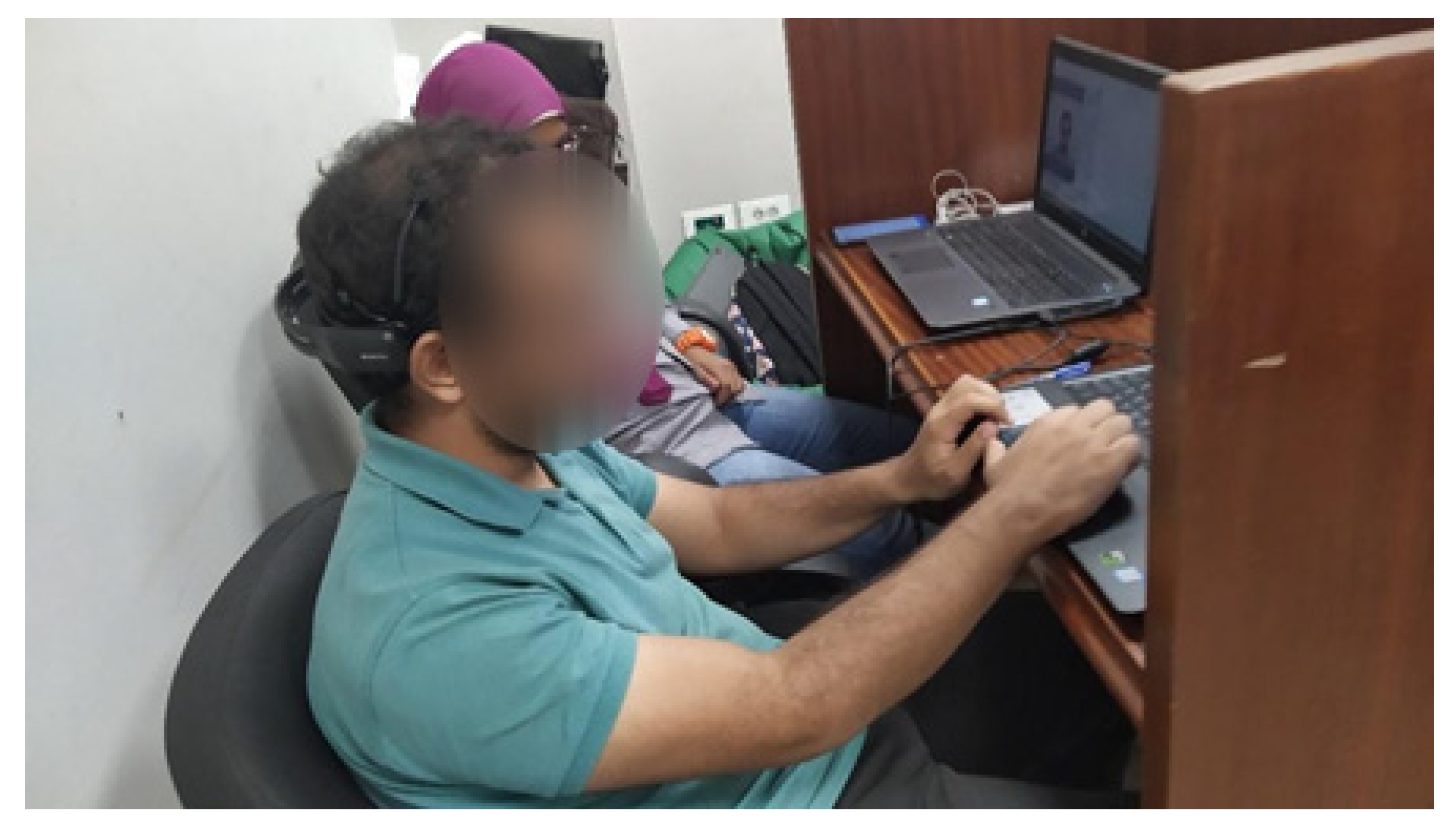
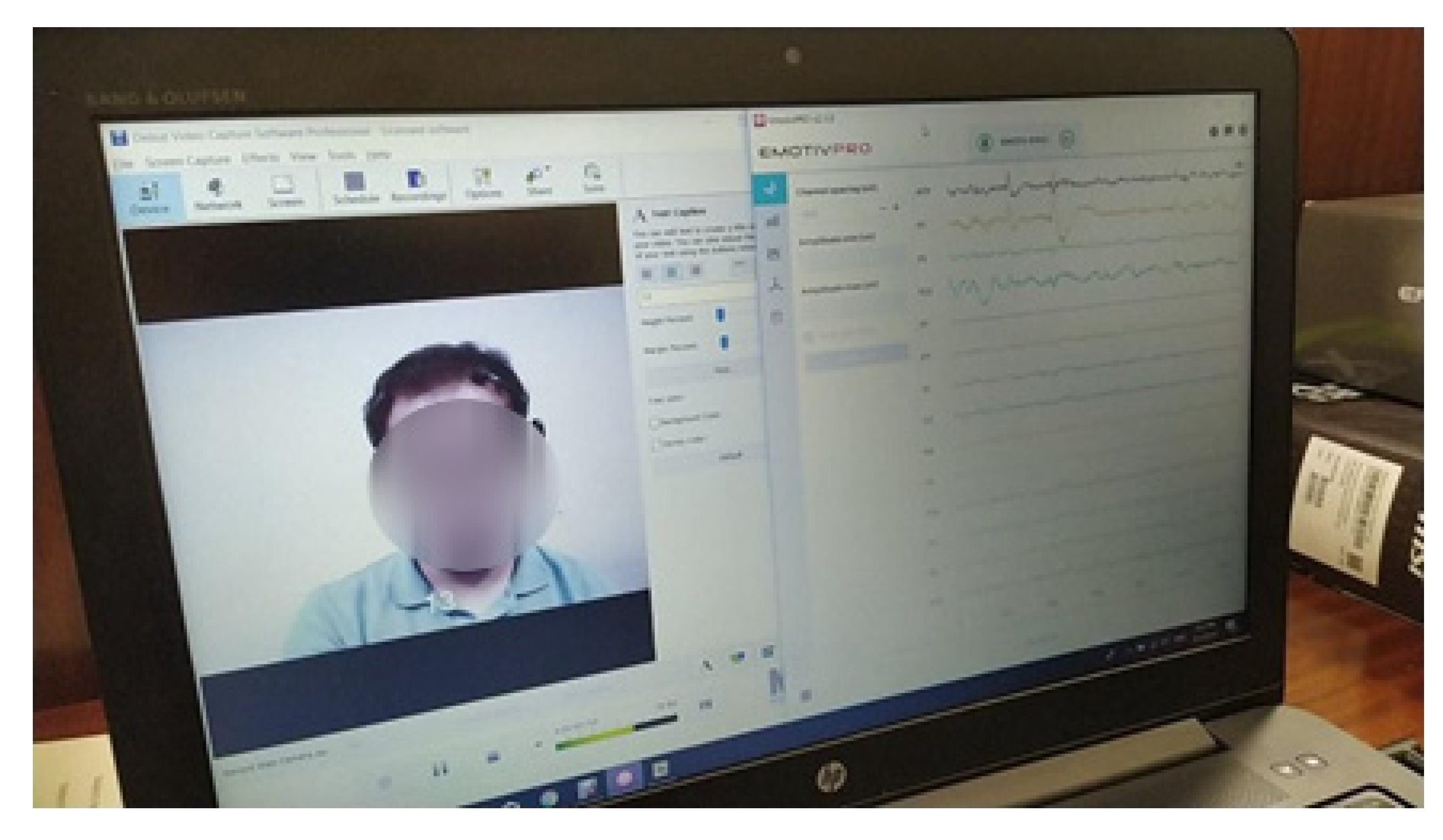
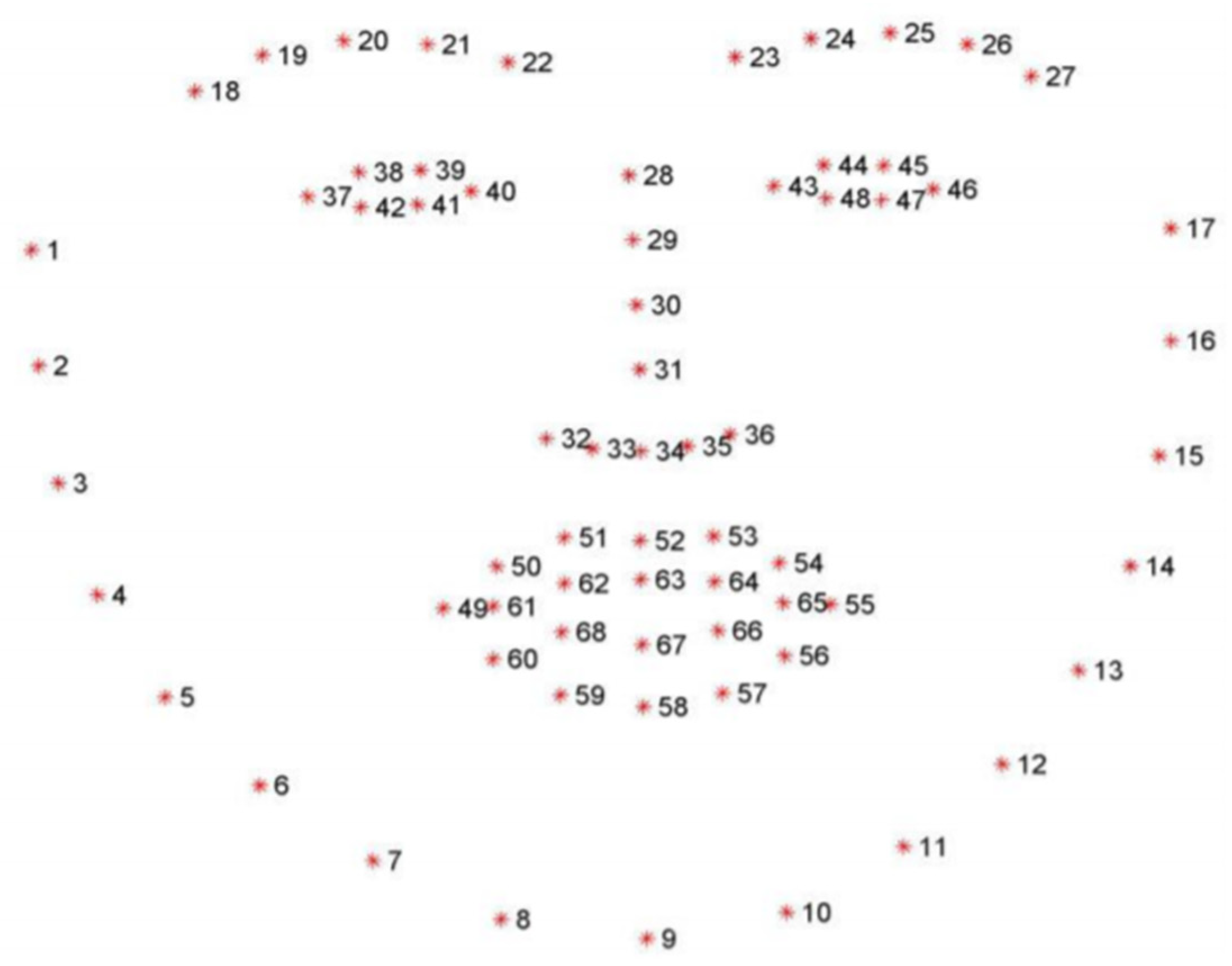
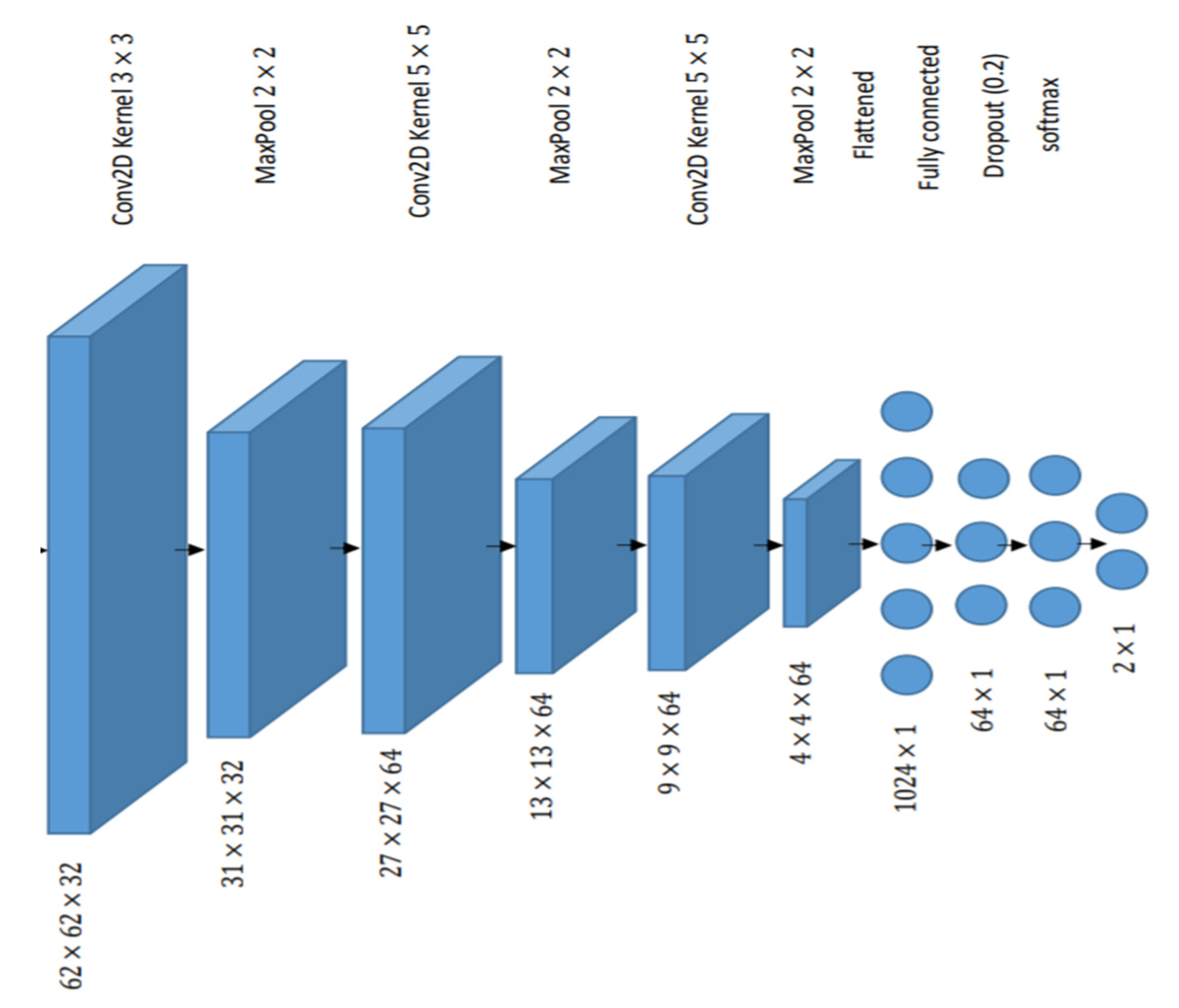


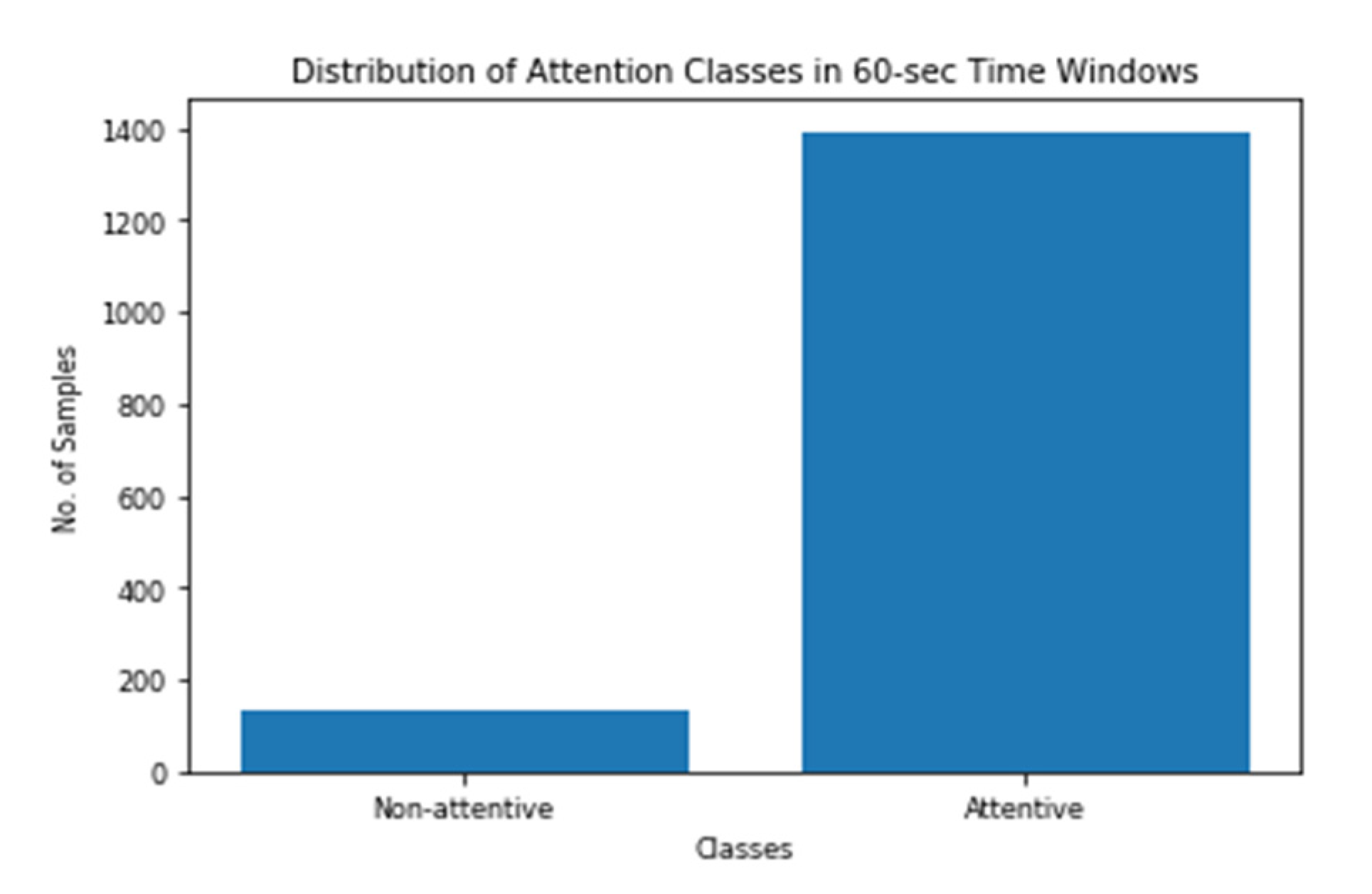
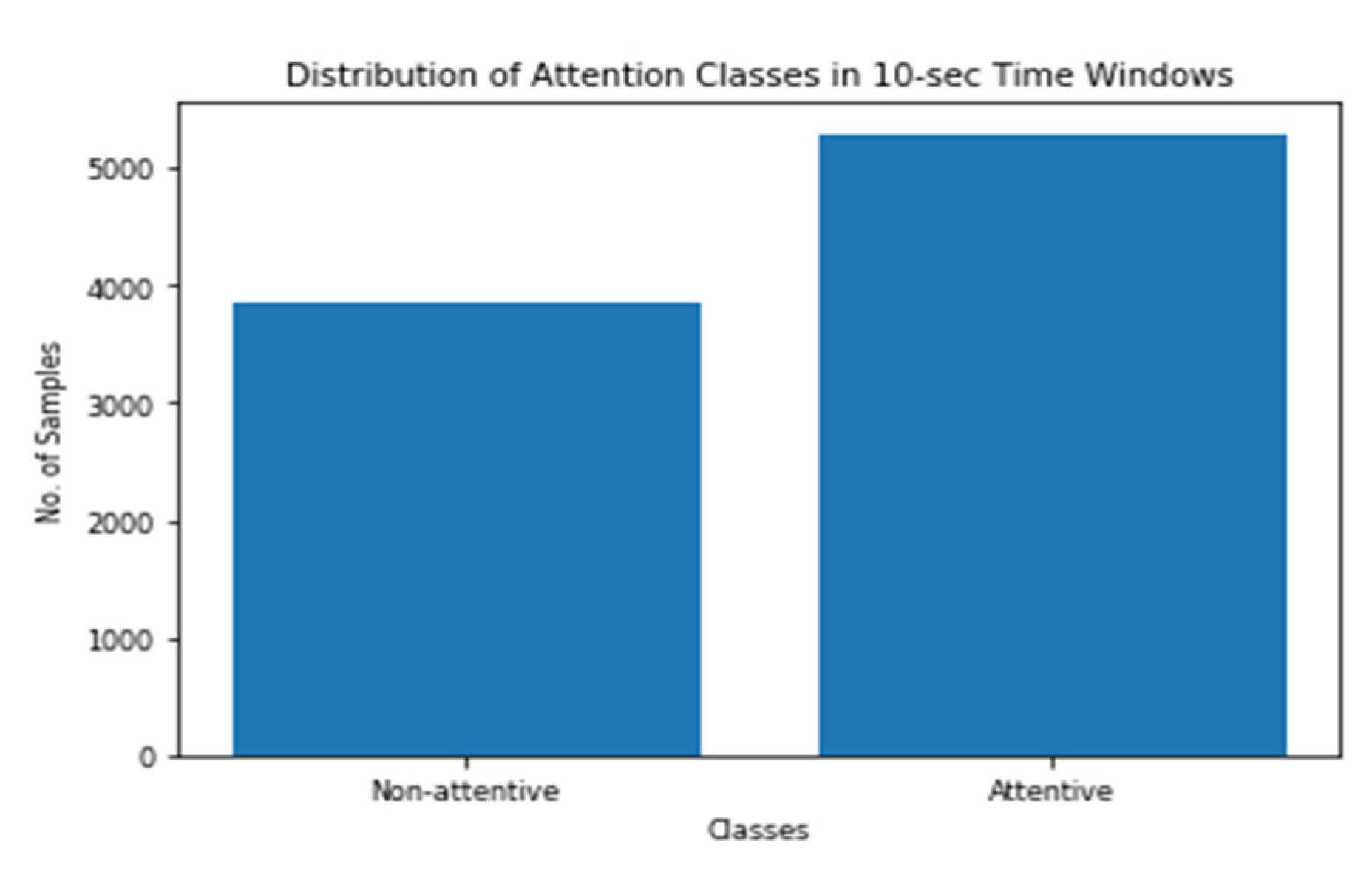
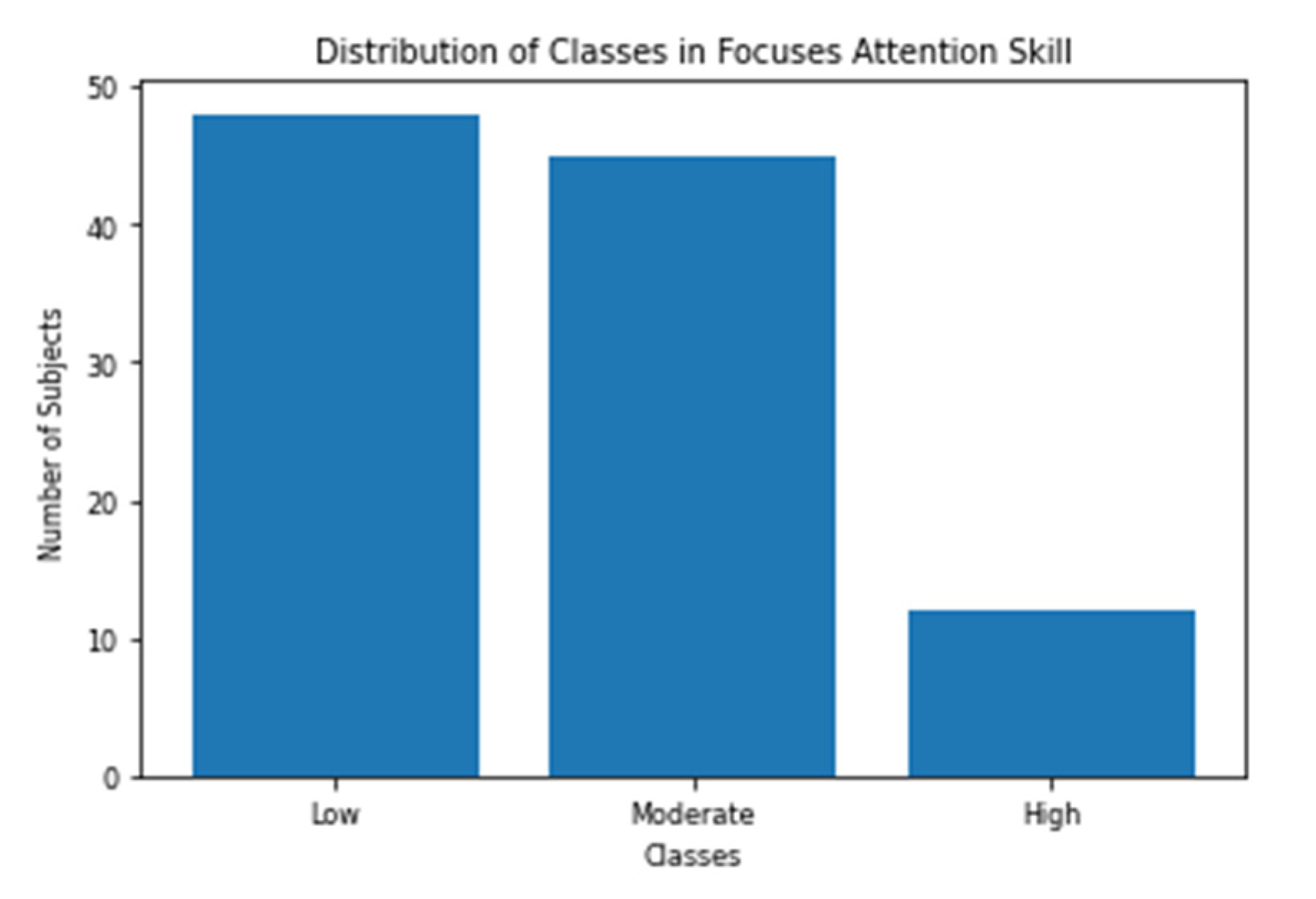
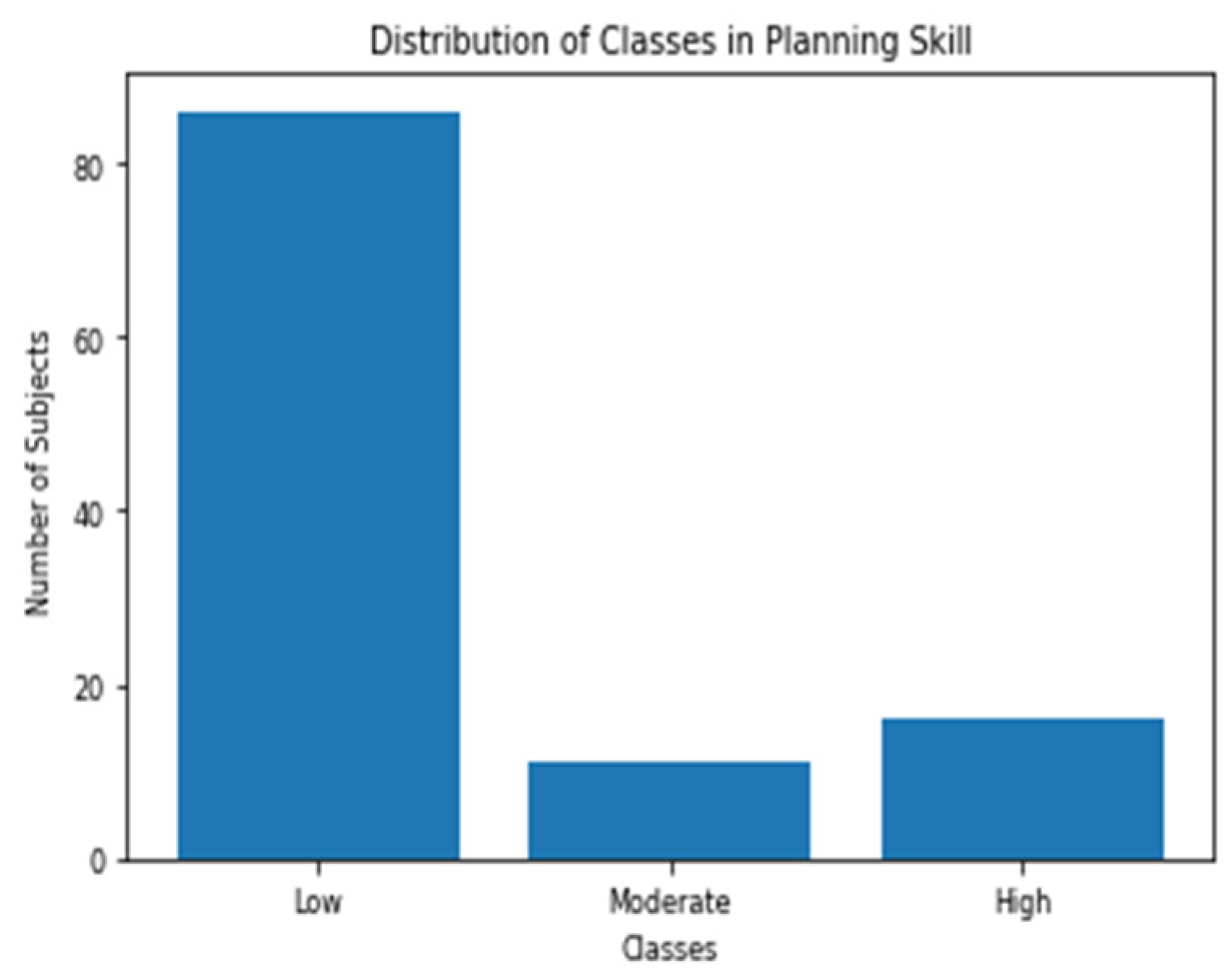
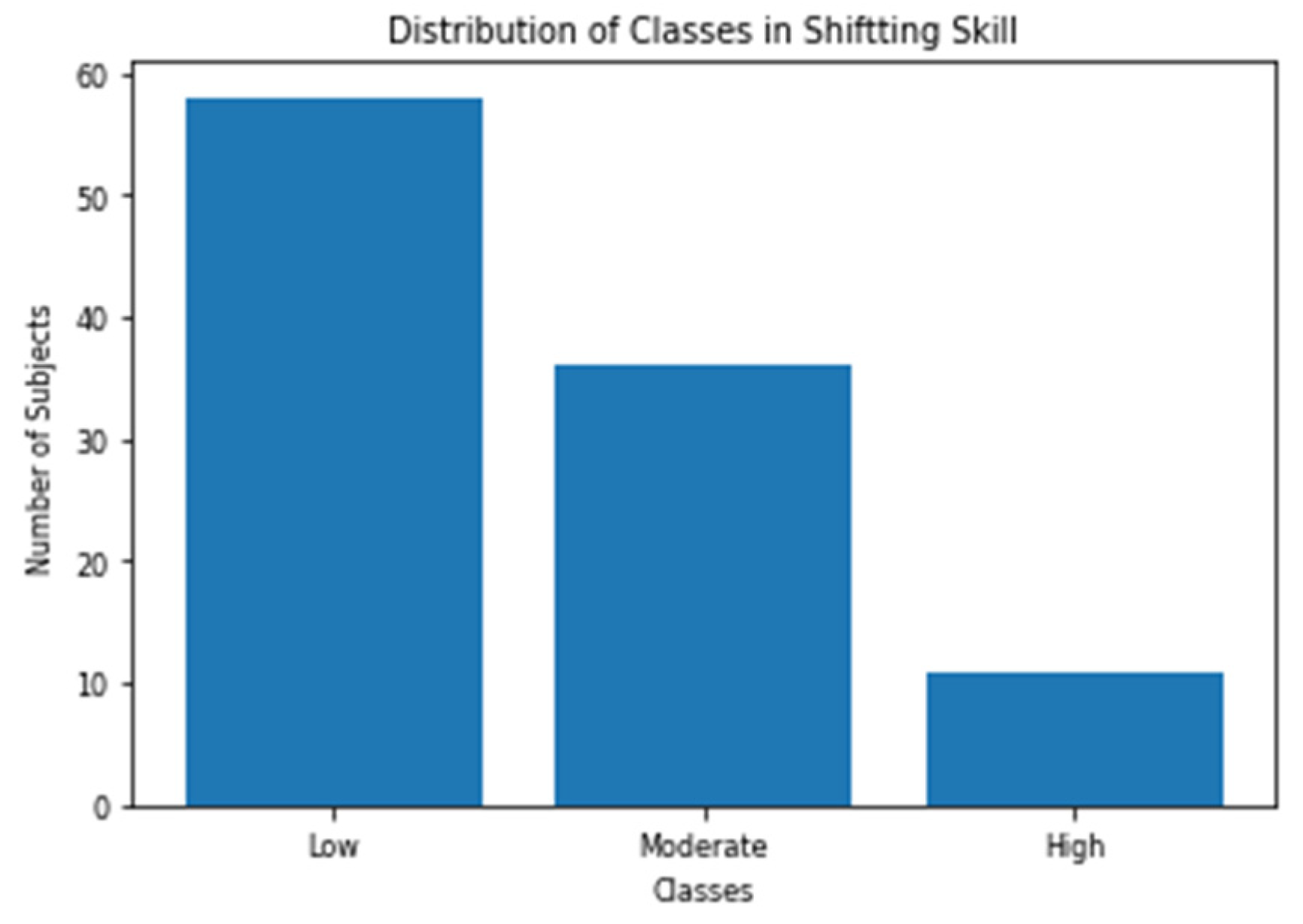

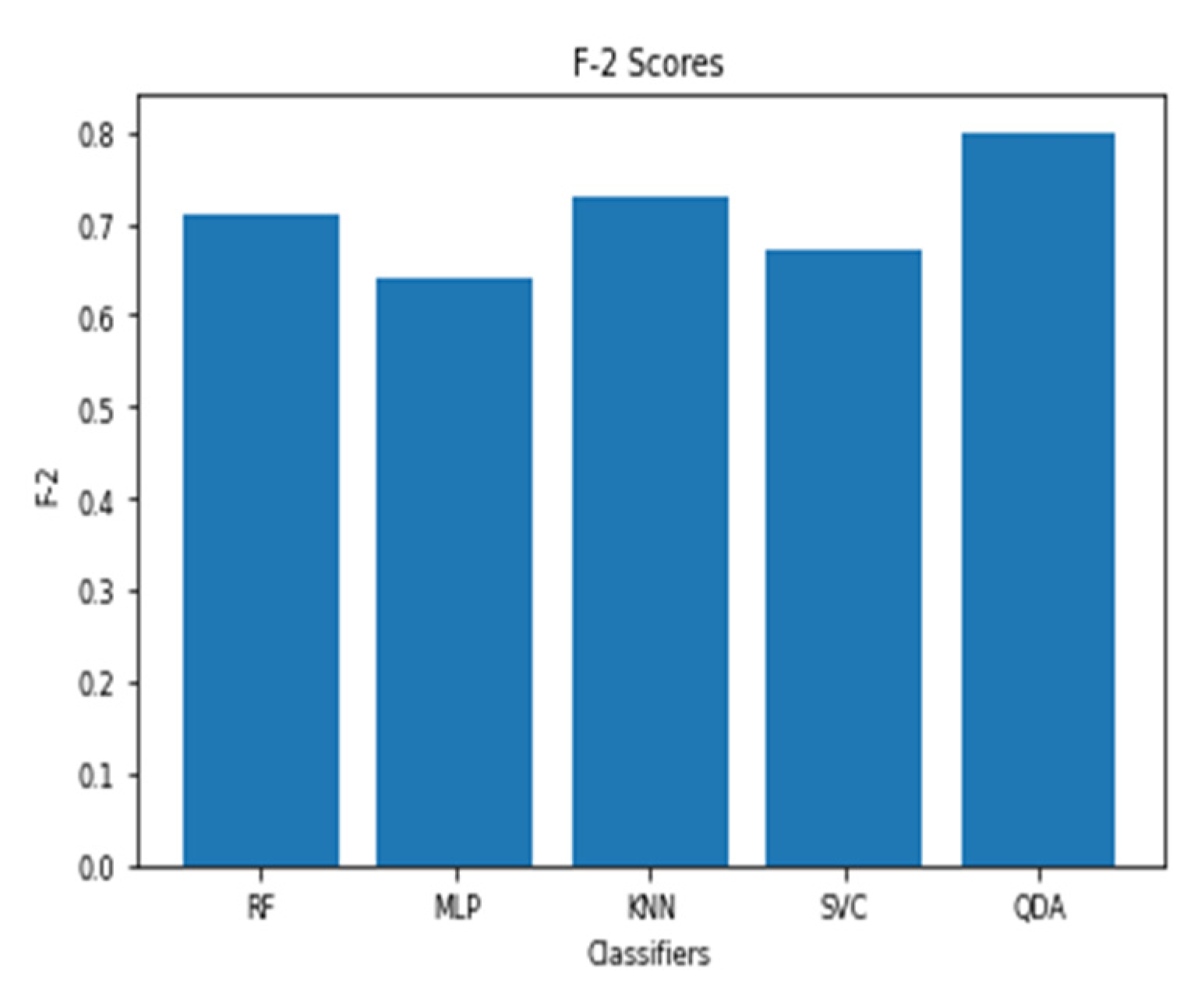
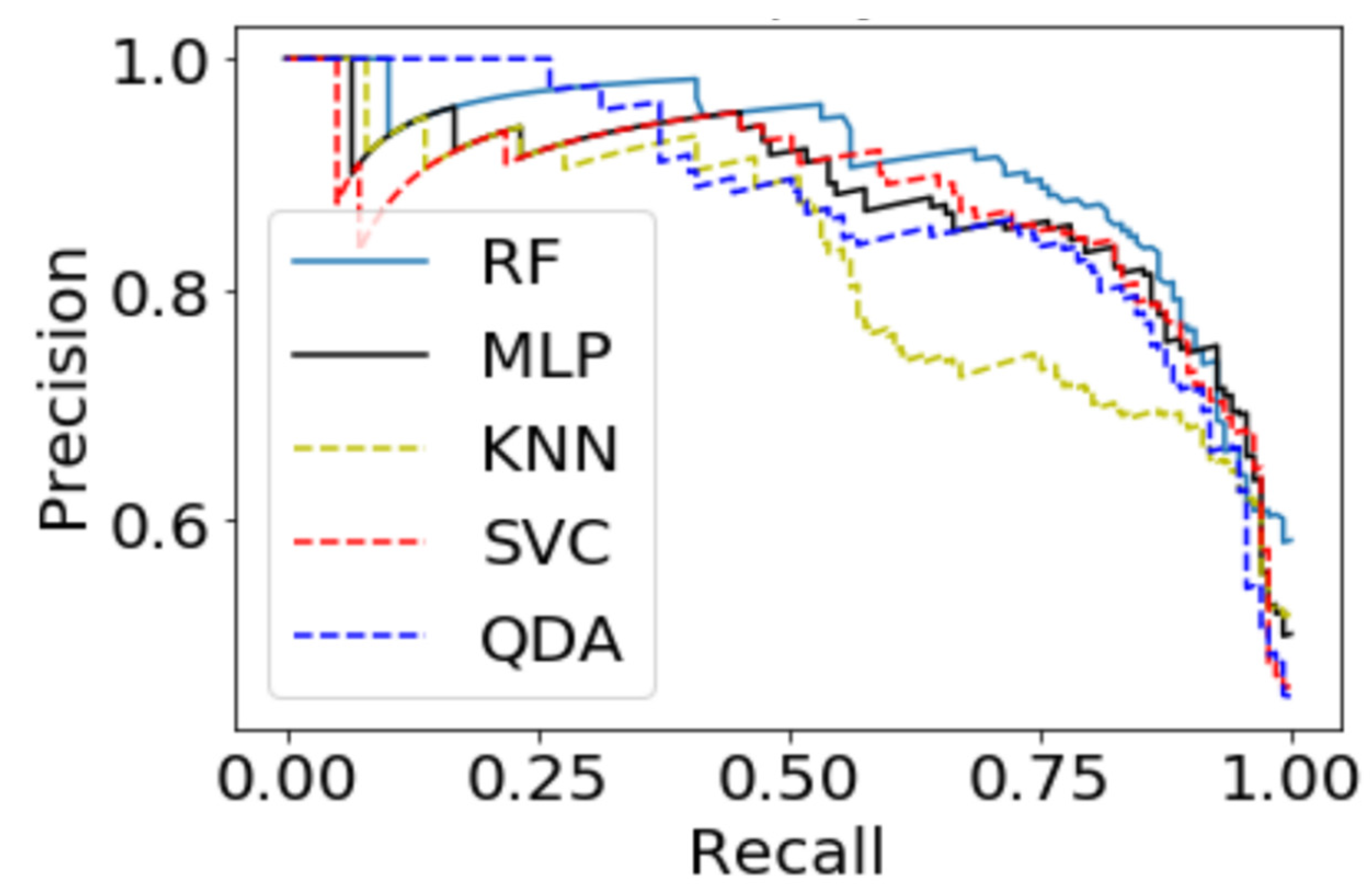
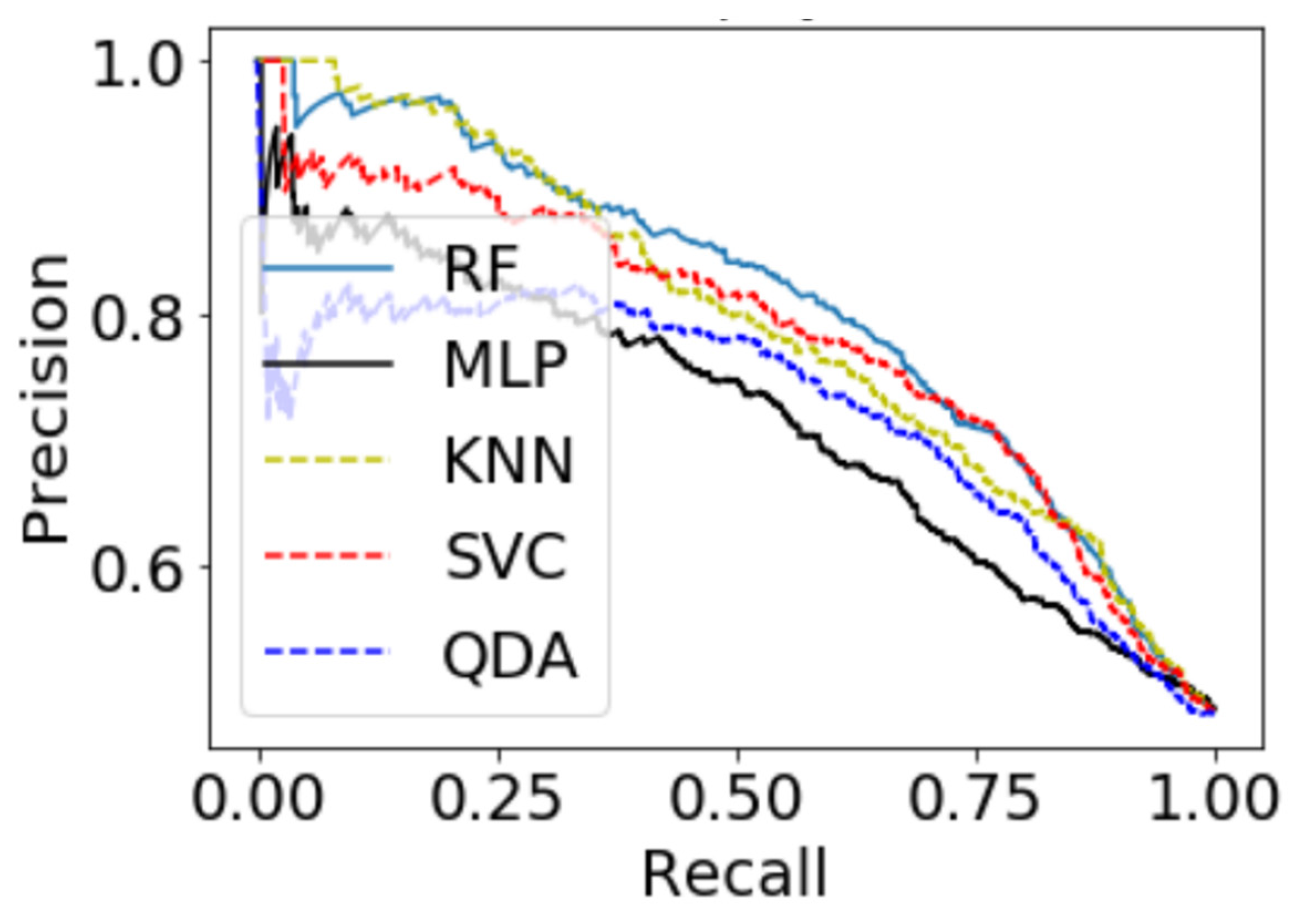




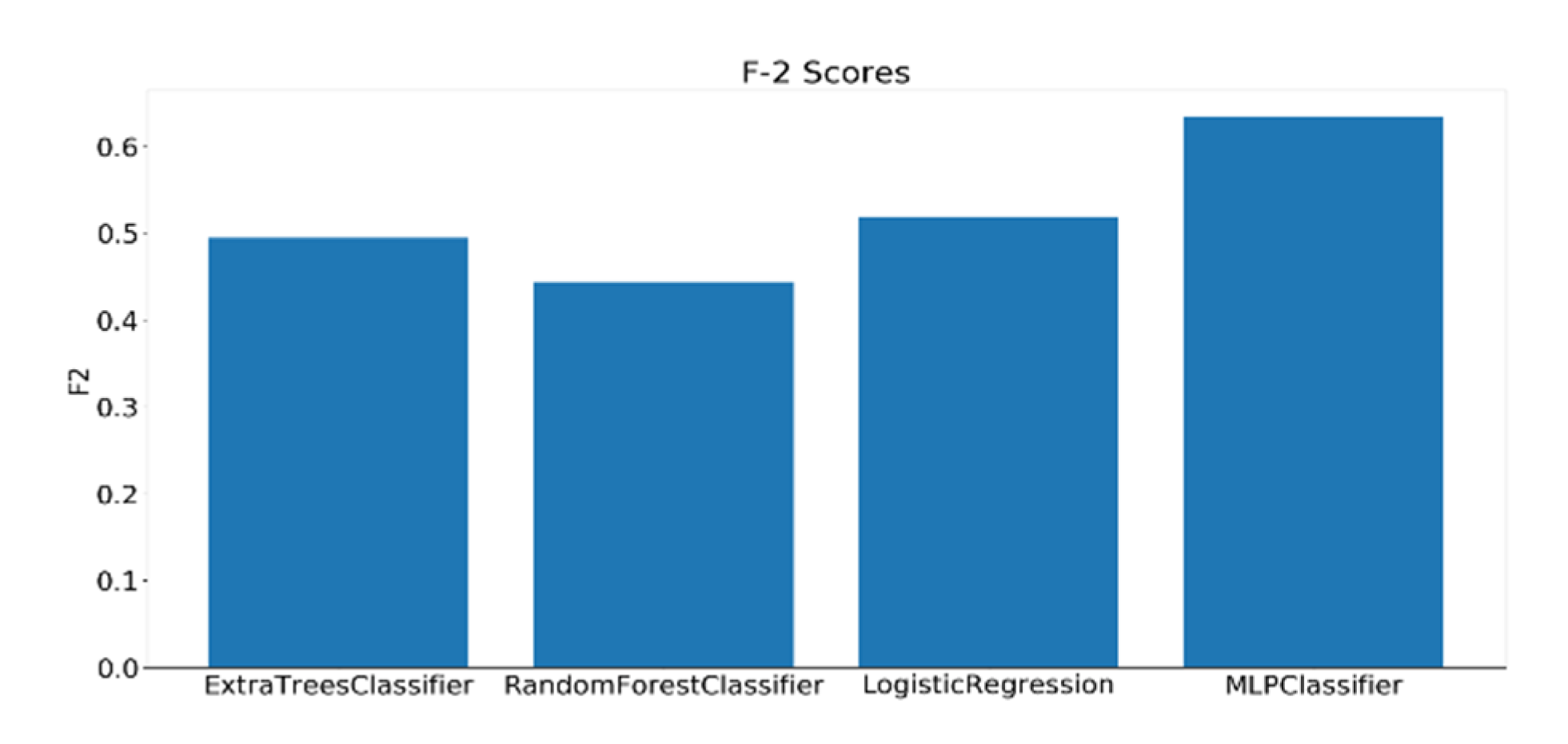
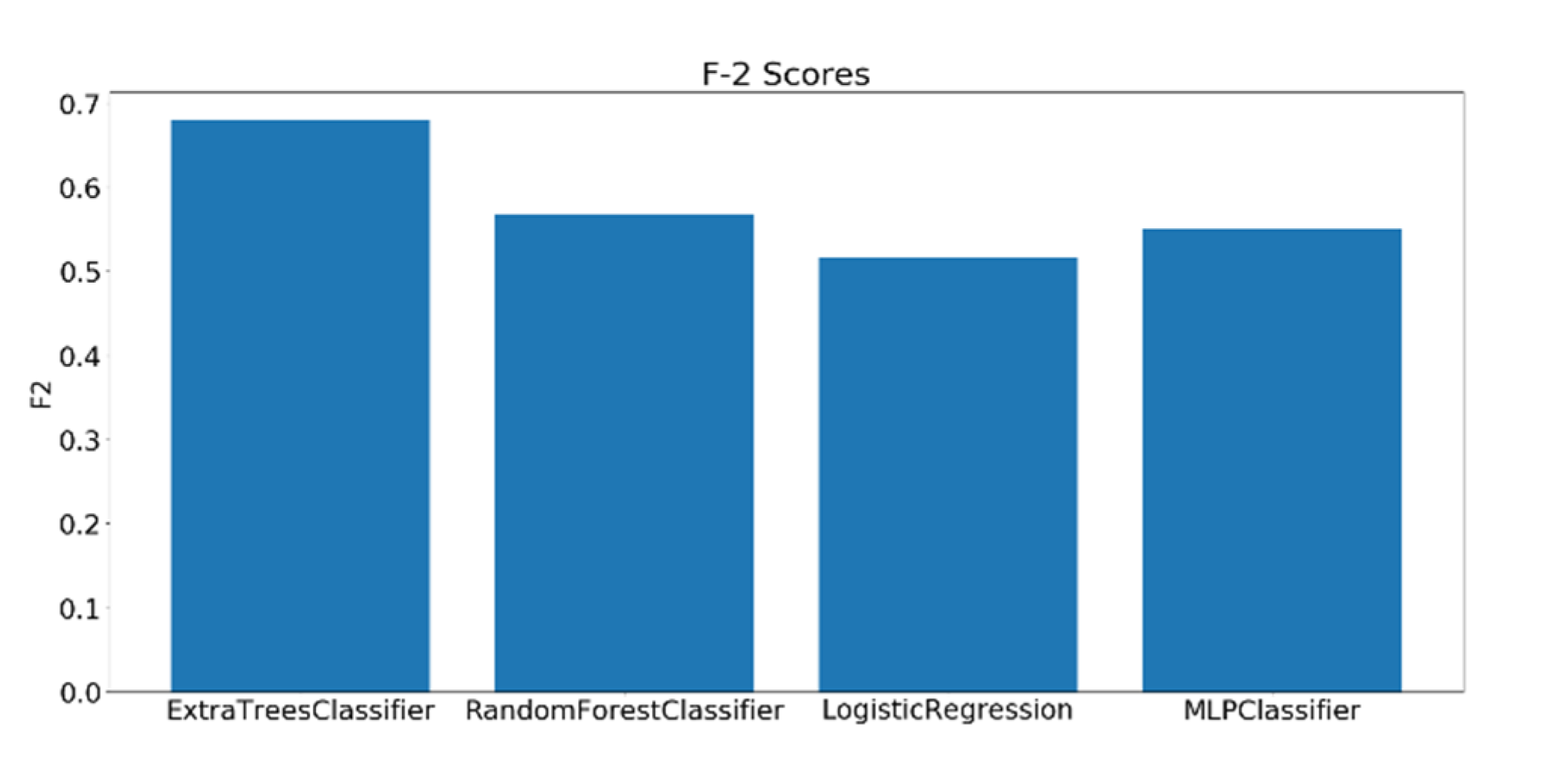
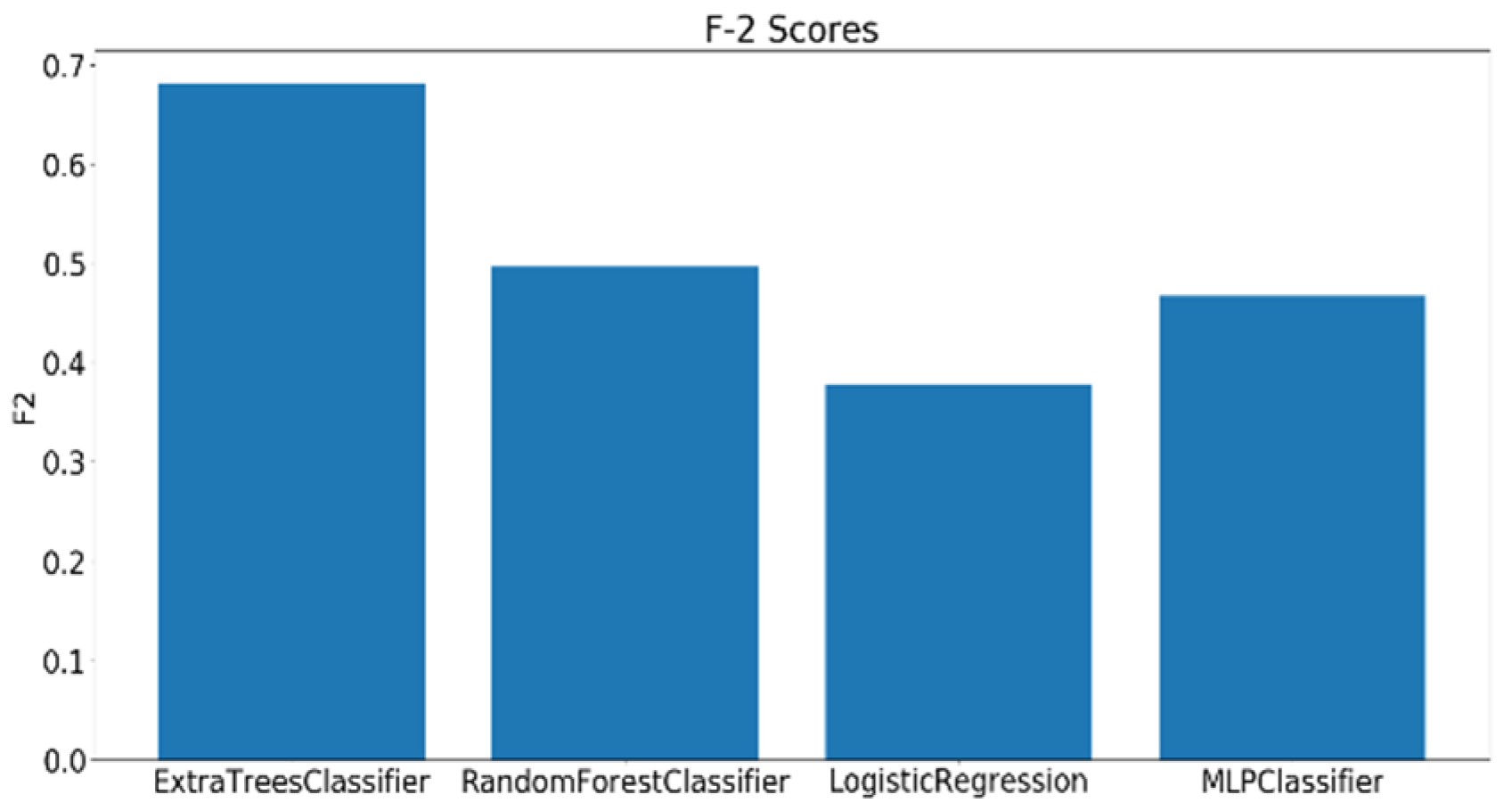

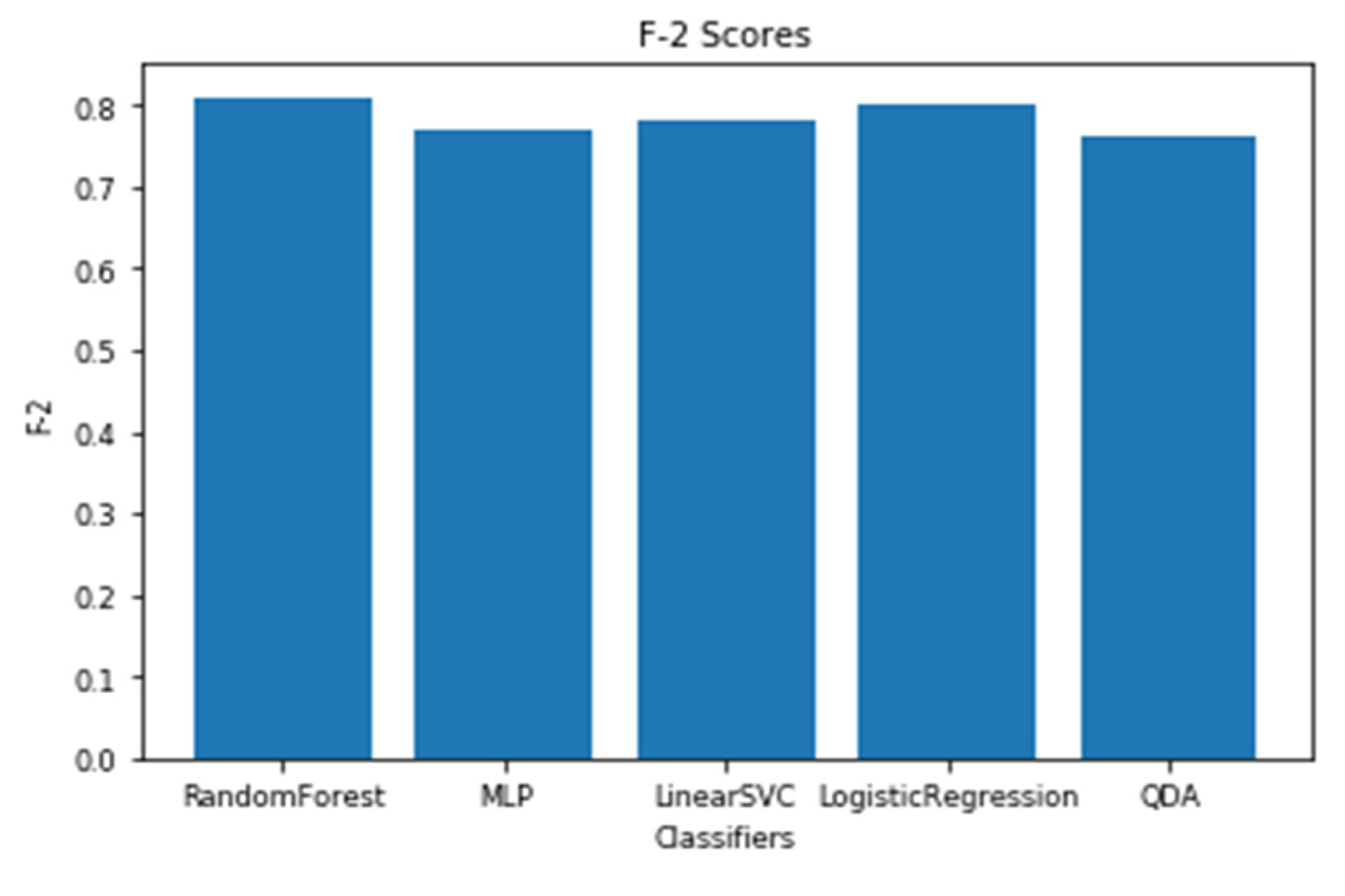
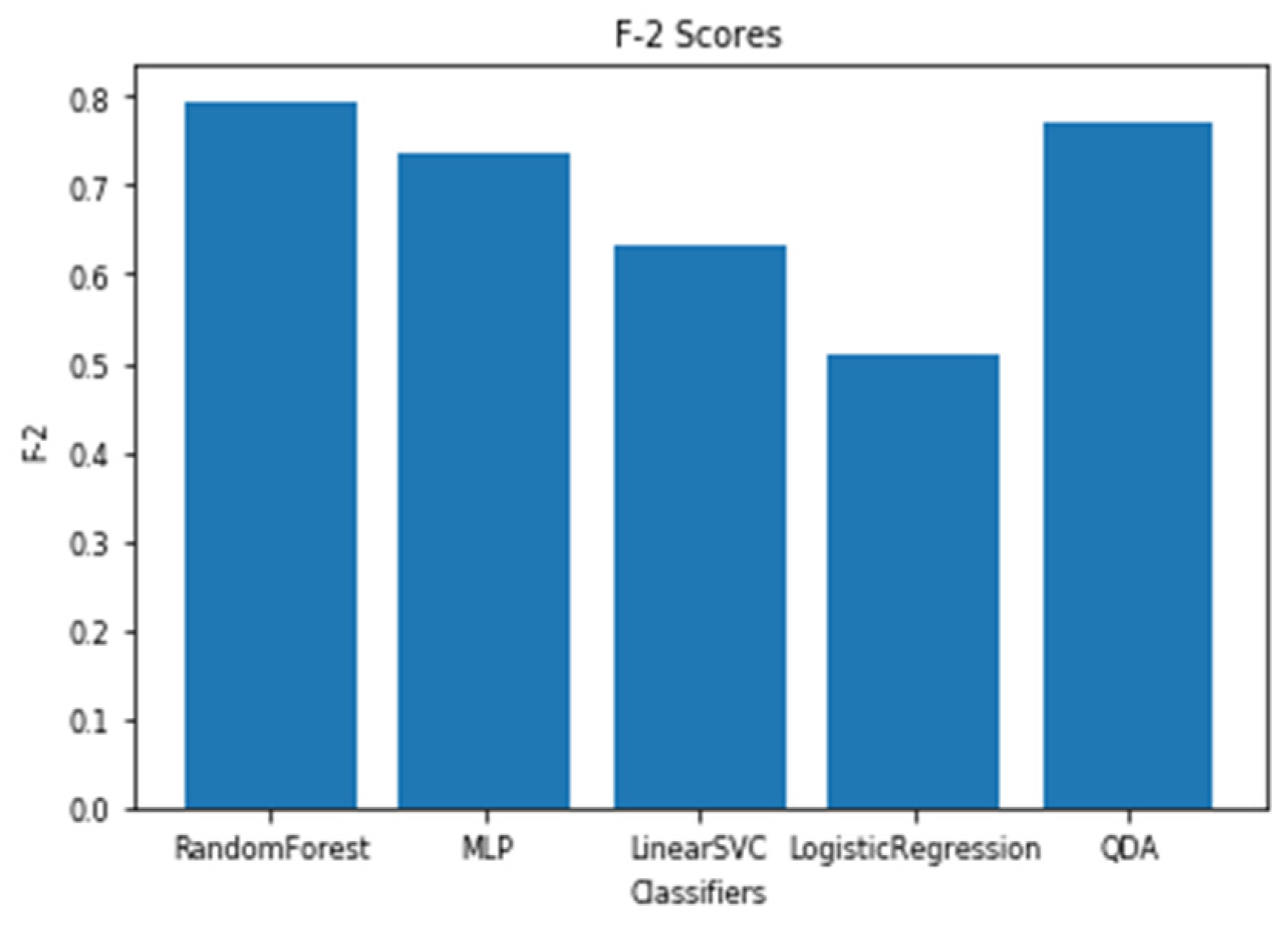
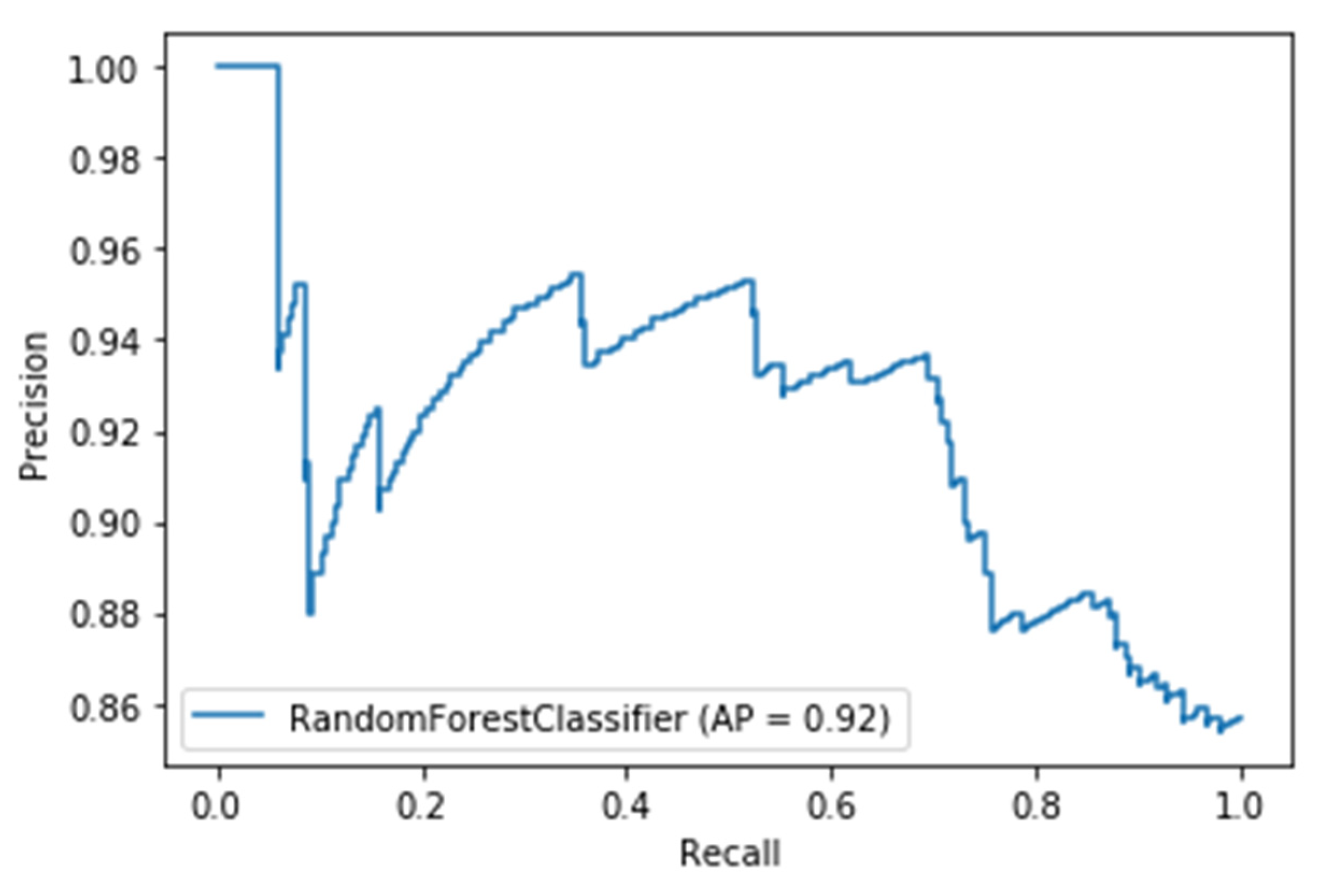
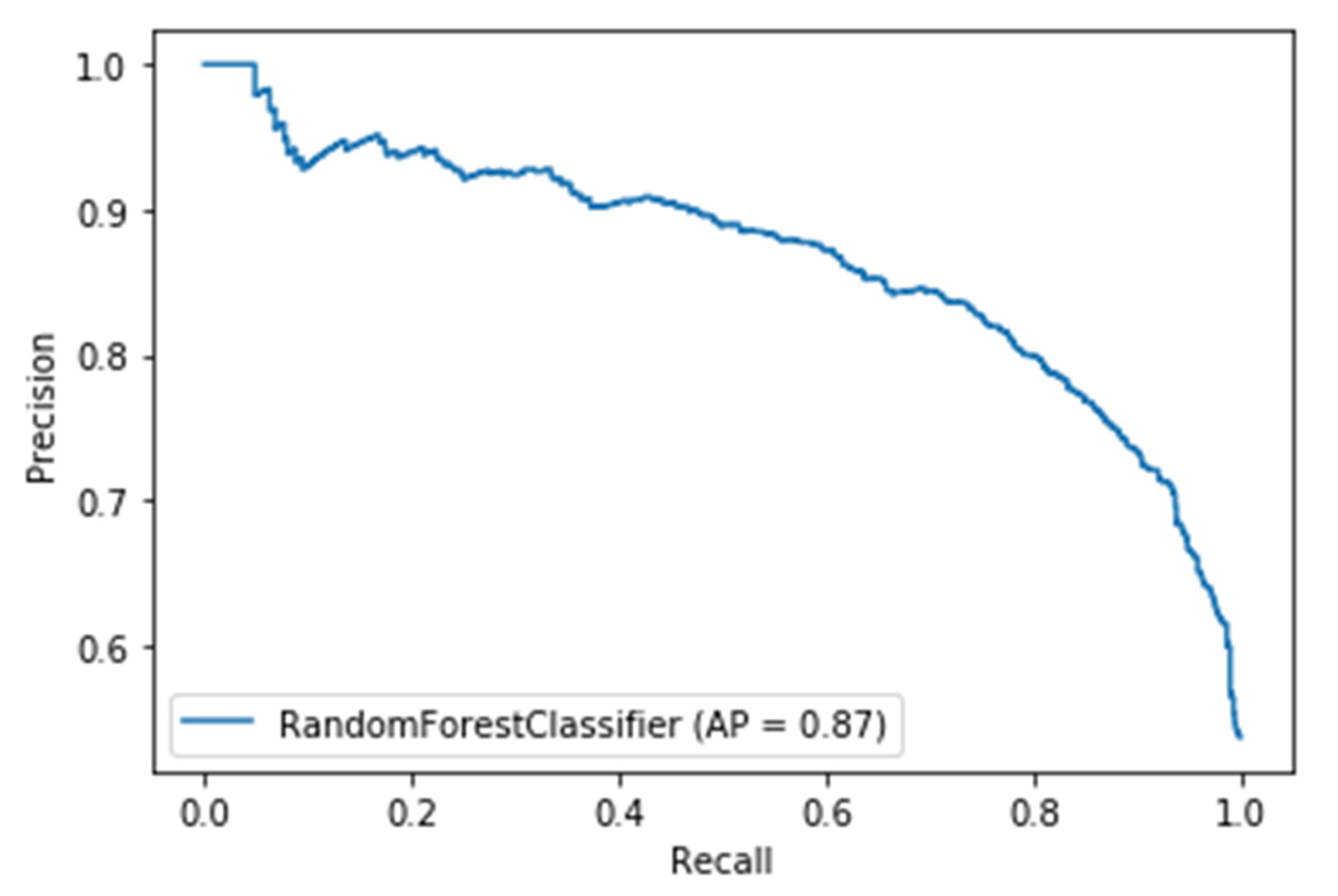


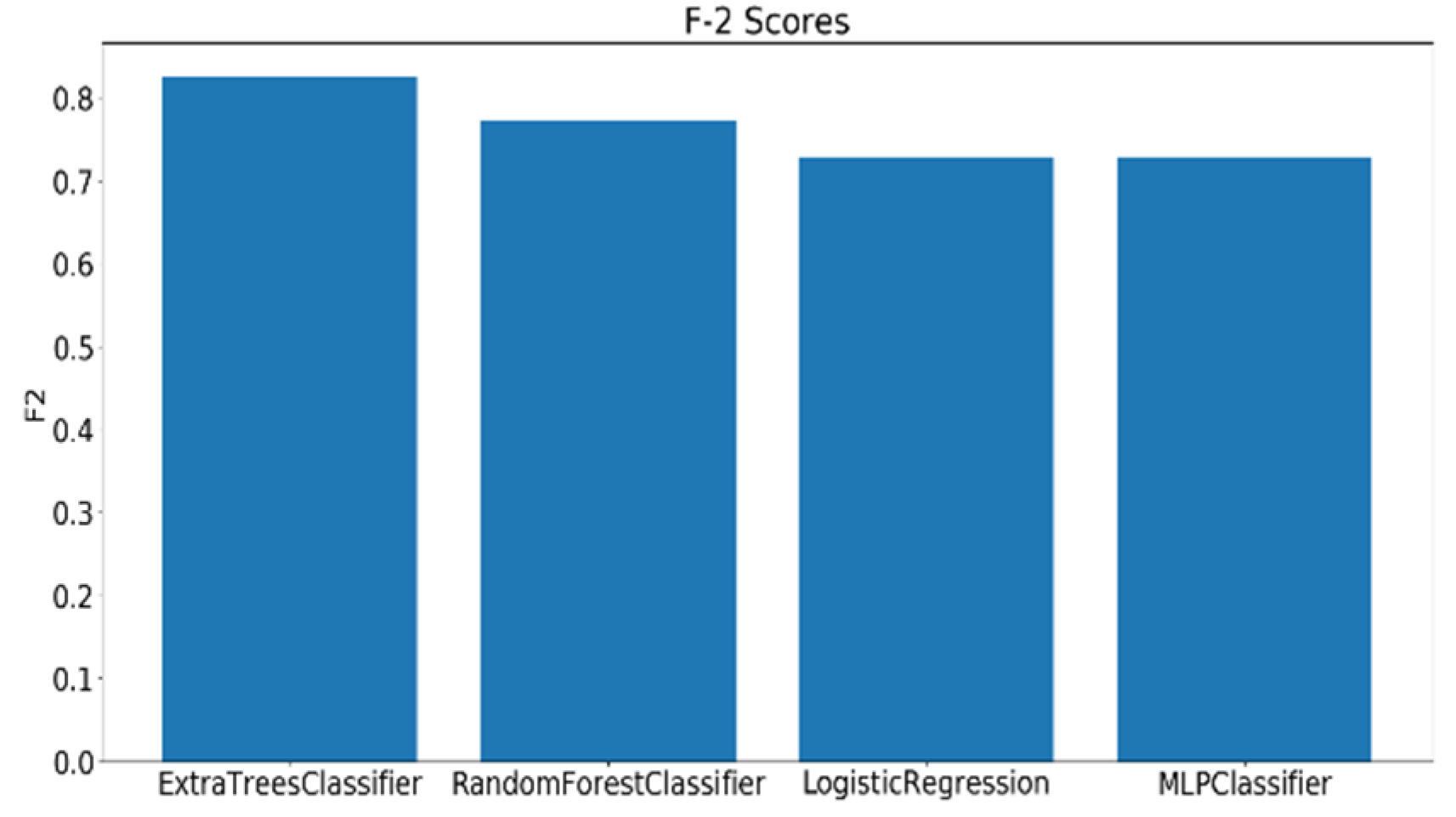
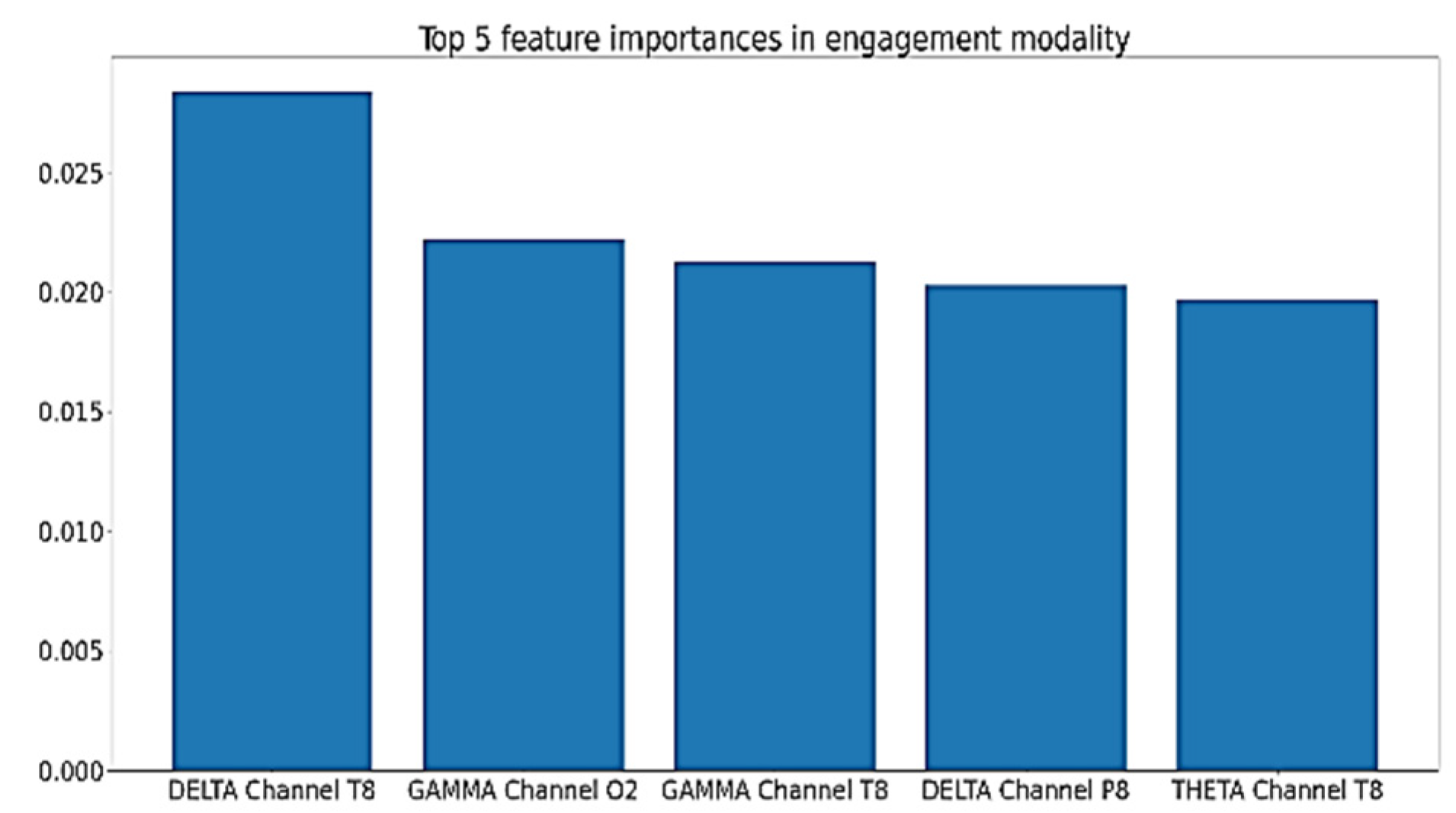
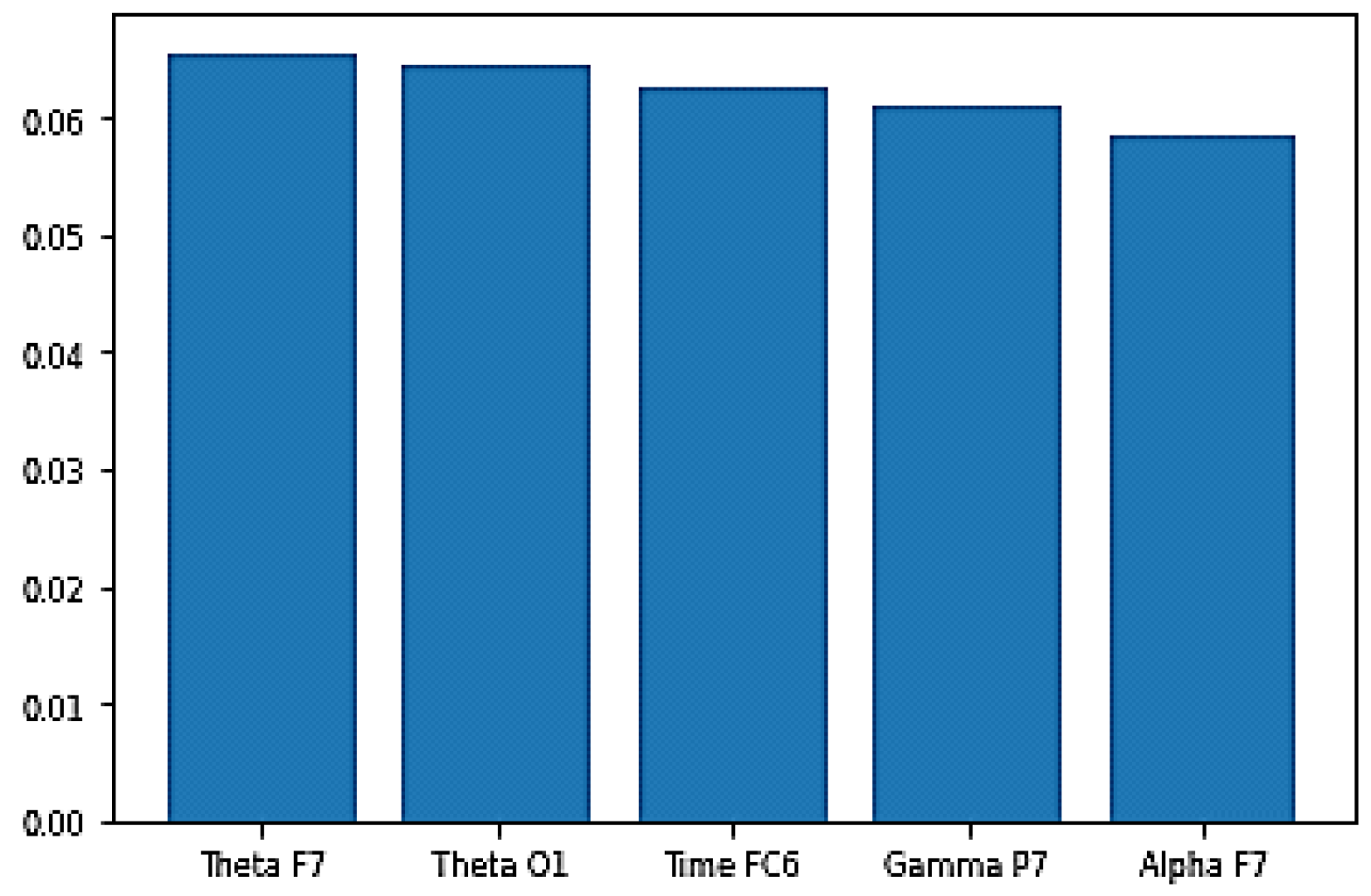
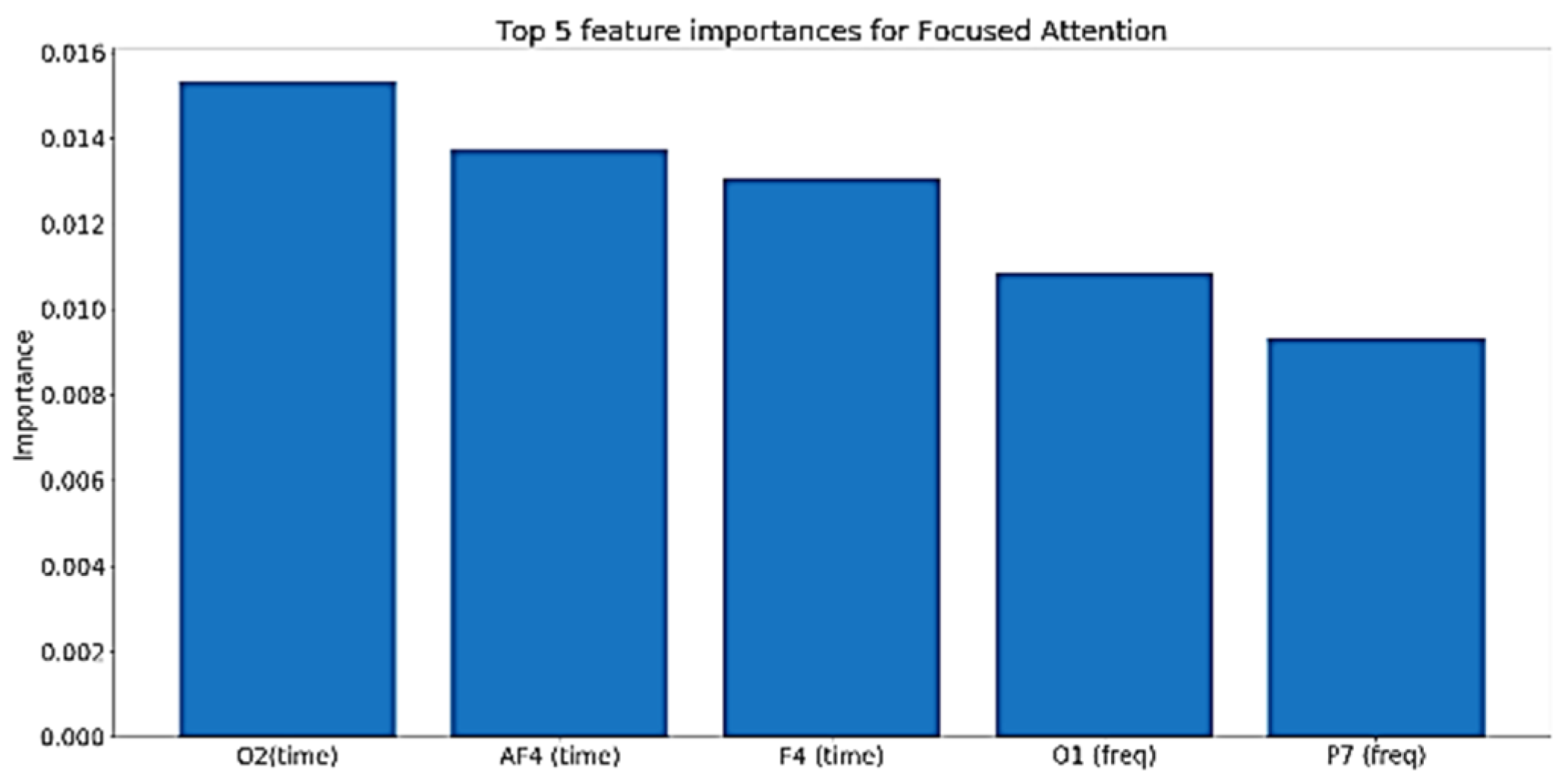
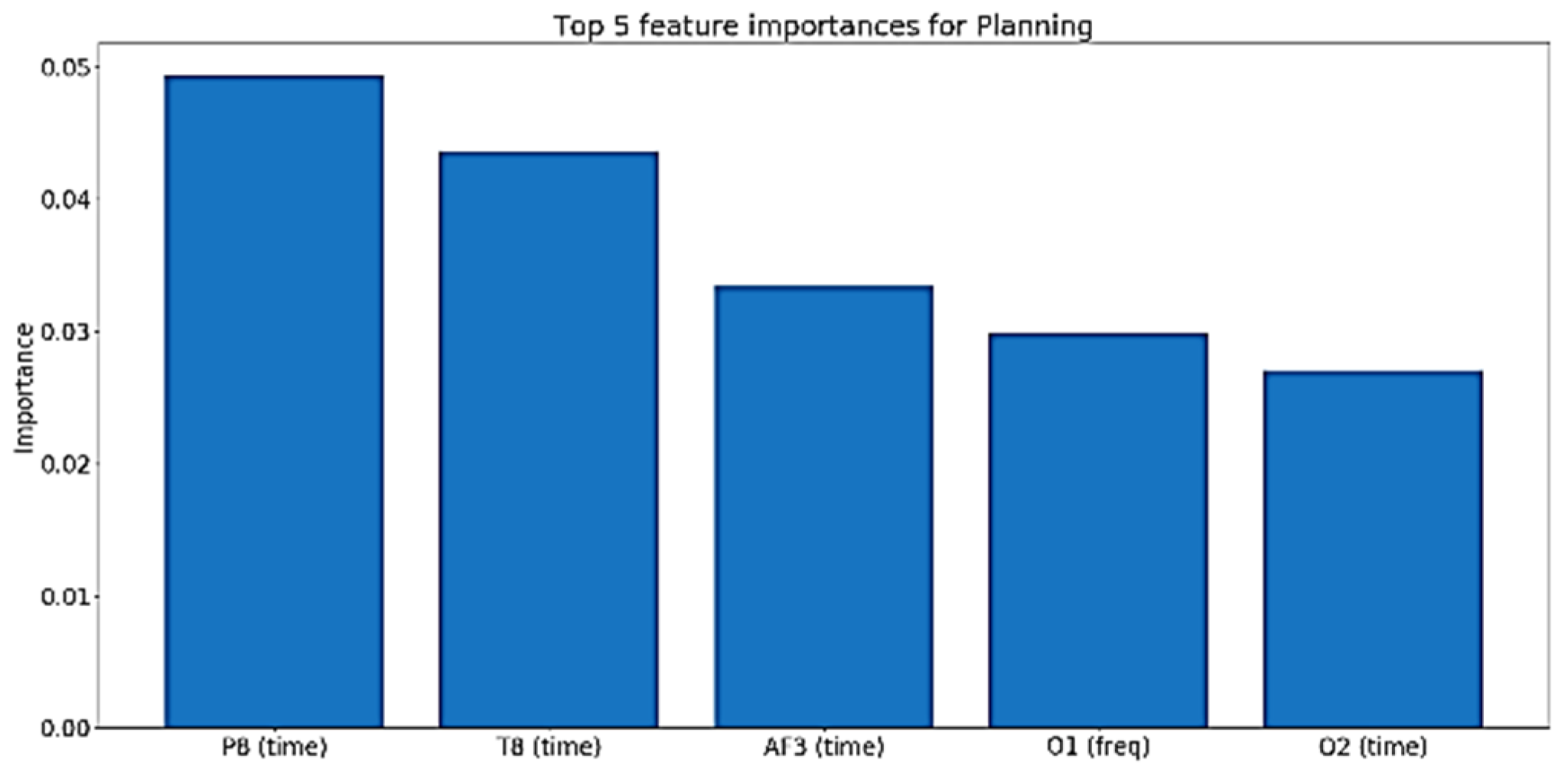
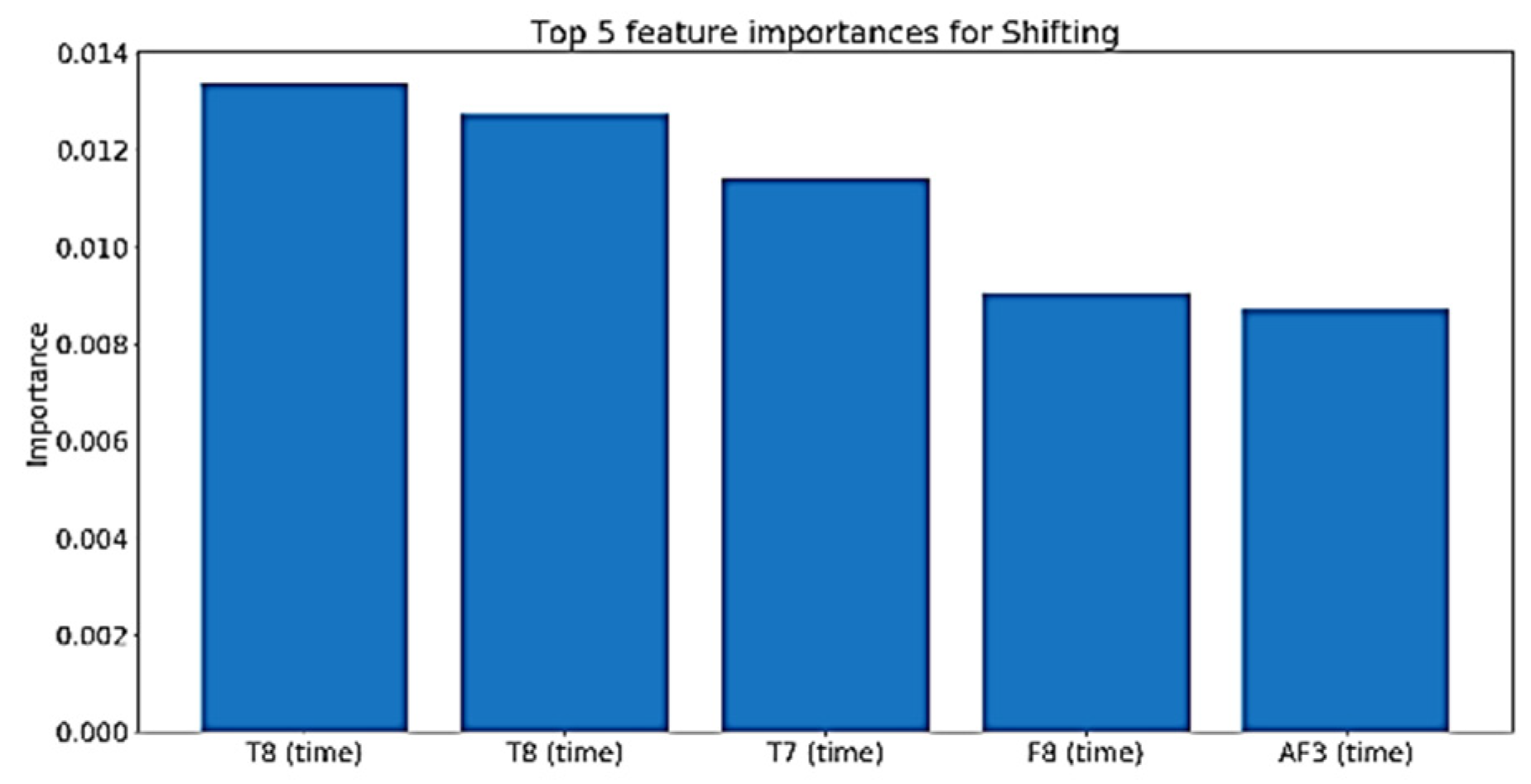
| Wavelet Coefficient | Frequency (Hz) | Signal Information |
|---|---|---|
| D1 | 250–500 | Noise |
| D2 | 125–250 | Noise |
| D3 | 63–125 | Noise |
| D4 | 32–63 | Gamma |
| D4 | 16–32 | Beta |
| D6 | 8–16 | Alpha |
| D7 | 4–6 | Theta |
| D8 | 0–4 | Delta |
| Focus | Best Model | F2 Score |
|---|---|---|
| EEG-based Engagement | Random Forests (with Gini criteria, number of estimators = 1000) | 0.86 |
| Facial expression-based Engagement | Convolutional Neural Network (See Figure 5 for the architecture) | 0.82 |
| EEG-based Instantaneous Attention | Random Forests (with Gini criteria, number of estimators = 100) | 0.82 |
| Facial expression-based Instantaneous Attention | Random Forests (with Gini criteria, number of estimators = 1000) | 0.81 |
| EEG-based Focused Attention | Multilayer Perceptron (a single layer with 50 nodes and a logistic activation) | 0.63 |
| Facial expression-based Focused Attention | Multilayer Perceptron | 0.53 |
| EEG-based Planning | Extra Trees (with Gini criteria and number of estimators = 400) | 0.68 |
| Facial expression-based Planning | Extra Trees | 0.78 |
| EEG-based Shifting | Extra Trees (with Gini criteria and number of estimators = 100) | 0.68 |
| Facial expression-based Shifting | Extra Trees | 0.81 |
© 2020 by the authors. Licensee MDPI, Basel, Switzerland. This article is an open access article distributed under the terms and conditions of the Creative Commons Attribution (CC BY) license (http://creativecommons.org/licenses/by/4.0/).
Share and Cite
El Kerdawy, M.; El Halaby, M.; Hassan, A.; Maher, M.; Fayed, H.; Shawky, D.; Badawi, A. The Automatic Detection of Cognition Using EEG and Facial Expressions. Sensors 2020, 20, 3516. https://doi.org/10.3390/s20123516
El Kerdawy M, El Halaby M, Hassan A, Maher M, Fayed H, Shawky D, Badawi A. The Automatic Detection of Cognition Using EEG and Facial Expressions. Sensors. 2020; 20(12):3516. https://doi.org/10.3390/s20123516
Chicago/Turabian StyleEl Kerdawy, Mohamed, Mohamed El Halaby, Afnan Hassan, Mohamed Maher, Hatem Fayed, Doaa Shawky, and Ashraf Badawi. 2020. "The Automatic Detection of Cognition Using EEG and Facial Expressions" Sensors 20, no. 12: 3516. https://doi.org/10.3390/s20123516
APA StyleEl Kerdawy, M., El Halaby, M., Hassan, A., Maher, M., Fayed, H., Shawky, D., & Badawi, A. (2020). The Automatic Detection of Cognition Using EEG and Facial Expressions. Sensors, 20(12), 3516. https://doi.org/10.3390/s20123516





